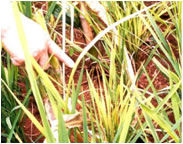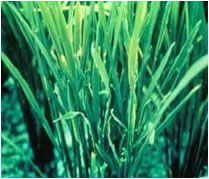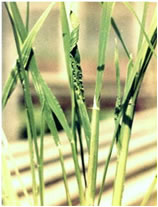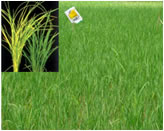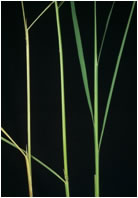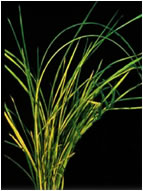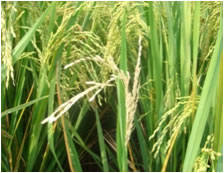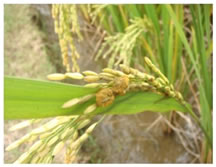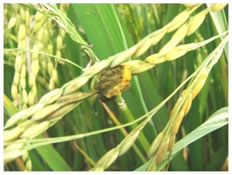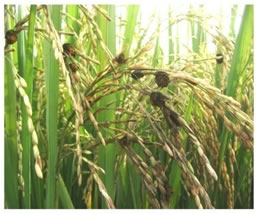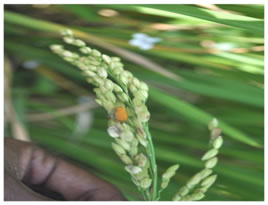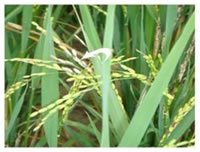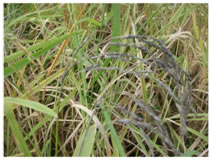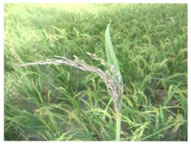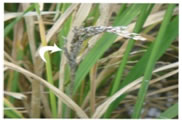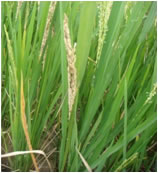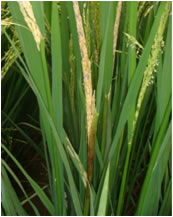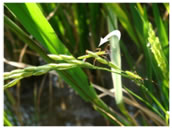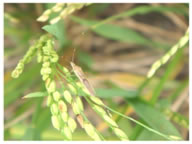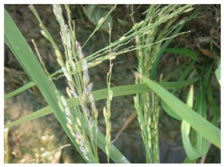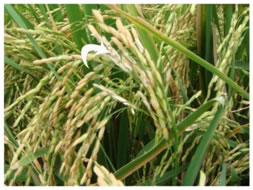
| Vegetative phase stage |
| Seedling stage at Nursery |
| Insect Pests | Symptom of Damage |
Advisory |
Image |
| Thrips: Stenchaetothrips biformis | • The crop is highly susceptible in the nursery stage for the first 23-25 days after transplanting/sowing.
• Nymphs and adults lacerate the tender leaves and suck the plant sap
• Terminal rolling and drying of leaves from tip to base (needle like) and turn whitish.
• In severe cases, Yellow (or) silvery streaks seen on the leaves of young seedlings.
• The infestation may be rated as mild, if there is less than three needle like leaves and considered to be severe, if there are more than three outgrowths with the lower leaves also showing chlorosis and scorching.
• The infestation invariably disappears after a rain fall. |
• Submerge infested crops intermittently for 1-2 days.
• Drag a wet cloth on the seedlings.
• Conserve bio control agents like predatory thrips, coccinellid beetles, anthocorid bugs, and staphylinid beetles found to feed on both the nymphs and adults.
• Phosphamidon 40SL @ 50ml (or) Endosulfan 35 EC @ 80 ml |
|
|
| Insect Pests | Symptom of Damage |
Advisory |
Image |
| Army worm: Mythimna separata (Walker) | • Larvae cut the seedlings in large scale.
• Caterpillars march in large numbers in the evening hours and feed on the leaves of paddy seedlings till the morning and hide during daytime.
• They feed gregariously and after feeding the plants in one field march onto the next field. Under severe infestation crop gives the grazed appearance of cattle.
• Attacked plants are reduced to stumps.
• Nurseries situated in ill-drained marshy areas attacked earlier than dry ground.
• Damage is severe during July to September. |
• Flood the nursery to expose the hiding larvae to the surface and thus they are picked up by birds.
• Apply kerosene to water to suffocate and kill the larvae.
• Allow the ducks into the field to feed the larvae.
• Drain the water from the nursery and spray chlorpyriphos 20 EC @ 80 ml or endosulfan 35 EC @ 80 ml during late evening hours. |
|
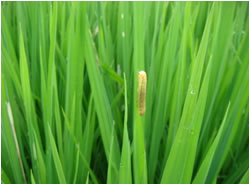 |
| Insect Pests | Symptom of Damage |
Advisory |
Image |
| Green Leafhopper: Nephotettix virescens | • Both nymphs and adults suck the plant sap from the leaf and leaf sheath result into yellowing of leaves from tip to downwards.
• It also act as a vector for transmitting plant diseases such as dwarf, transitory yellowing, yellow dwarf and rice tungro virus (Tungro is transmitted during short feeding period). |
• Use resistant varieties like IR 50, CR 1009, Co 46, PTB 2 and PTB 18. Nursery should not be raised near the lamp posts.
• Apply neem cake @ 12.5 Kg/20 cent nursery as basal dose.
• Apply anyone of the following insecticide: Carbofuran 3 G @ 3.5 kg (or) Phorate 10 G @ 1.0 kg (or) Quinalphos 5 G @2.0 kg |
|
| Insect Pests | Symptom of Damage |
Advisory |
Image |
| Case worm: Nymphula depunctalis | • The caterpillar cuts a piece of leaf roll it longitudinally into a tubular structure and remains inside.
• It feeds by scraping the green tissue of the leaf and leave them papery.
• Tubular cases often float in the water. |
• Mix 250 ml of kerosene to the standing water
• Dislodge the cases by passing a rope and drain water
• Collect the cases and destroy them.
• Spray any one of the following insecticide: Monocrotophos 36 SL @ 40 ml (or) Quinalphos 25 EC @ 80 ml. |
|
| Non insect pest | Symptom of Damage |
Advisory |
Image |
| Golden apple Snail: Pomacea canaliculata | • Missing seedlings/hills
• Floating of cut leaves
• Cut stems
• Decreased plant stand
• Sparse or uneven stand |
Cultural method
• Planting older seedlings, planting at higher densities, or planting on ridges above the water line.
• Proper leveling of field.
• practice off-season tillage to crush snails and expose them to sun.
• Ensure proper drainage to field.
• Crop rotation with a dryland crop and allow the land fallow for some period.
• Construct canalets along bunds and inside paddyfield for easy drainage and collection of snails.
• Atractants like newspaper can be used.
• Good water management by proper levelling for the first two weeks is recommended.
Mechanical method
• Install screens with 5 mm mesh at water inlets to minimize the entry of snails into the rice fields and facilitate collection by hand.
• Handpicking and crushing, staking with bamboo or other wooden stakes before and after transplanting to facilitate egg mass collection.
• Use of a hand-operated device to smash egg clusters between two snail egg clappers.
Biological method
• Use of fishes like common carp, Japanese crucian, heron, and weasels as biological control agents.
• A firefly nymph is also act as effective natural enemy for snail.
• Herding ducks and raising fish in the paddy field.
• Birds prey on both eggs and neonates. Rats and snakes also feed on them.
Chemical method
|
|
| Planting to tillering |
| Insect Pests | Symptom of Damage |
Advisory |
Image |
| Brown plant leafhopper: Nilaparvata lugens | • Nymphs and adults congregate at the base of the plant above the water level and suck the sap
• Affected plant dries up and gives a scorched appearance called "hopper burn".
• Circular patches of drying and lodging of matured plant
• It is a vector of grassy stunt, ragged stunt and wilted stunt diseases |
• Use resistant/tolerant varieties like Aruna, ADT 36, Co 42, Co 46 IR 36, IR 72.
• Avoid close planting.
• Provide 30 cm rogue spacing at every 2.5 m to reduce the pest incidence.
• Avoid use of excessive nitrogenous fertilizers.
• Control irrigation by intermittent draining.
• Set up light traps during night.
• Set up Yellow pan traps during day time.
• Conserve natural enemies like spider Lycosa pseudoannulata, Cyrtorhinus lividipennis.
• Avoid synthetic pyrethroids, methyl parathion, fenthion and quinalphos causes resurgence of this pest
• Drain the water before the spraying insecticides.
• Apply any one of the following insecticides: Phosphamidon 40 SL@ 1000 ml/ha; Monocrotophos 36 SL @ 1250 ml/ha; Carbofuran 3 G @ 17.5 kg/ha; Imidacloprid 18.5@ 100 ml/ha; Thiomethoxam 20 WDG@ 100 ml/ha; Dichlorvos 76 WSC @ 350 ml/ ha; Neem oil 3% @ 15 lit/ha; Iluppai oil 6% @ 30 lit/ha; Neem seed kernel extract 5% @ 25 kg/ha
|
|
| Insect Pests | Symptom of Damage |
Advisory |
Image |
| White backed plant hopper: Sogatella furcifera | • Suck the sap and cause stunted growth.
• 'Hopper burn' is caused in irregular patches. |
Cultural control: • Avoid use of excessive nitrogenous fertilizers
• Control irrigation by intermittent draining
• Use varieties released by IRRI, which contain genes for WBPH resistance, like IR26, IR64, IR36, IR56, and IR72.
• Avoid close planting and provide 30 cm rogue spacing at every 2.5 to 3.0 m to reduce the pest incidence.
• Set up light traps during night
• Use yellow pan traps during day time
• WBPH population can be regulated by natural biological control agents
• Release egg parasitoid Anagrus sp and adults and nymphs of Pachygonatopus sp.
• Conserve Coccinellid beetles, staphylinid beetles, carabid beetles, hydrophilid, dytiscid beetles, dragonflies, damselflies, wasps, lygaeid bugs, Predatory mites and spiders search the plant for WBPH nymphs and adults.
Economic threshold level
1 hopper/ tiller in the absence of predatory spider and 2 hoppers /tiller when spider is present at 1/hill.
Spray any one of the following insecticide
• Phosphamidon 40 SL@ 1000 ml/ha
• Monocrotophos 36 SL @ 1250 ml/ha
• Carbofuran 3 G @ 17.5 kg/ha
• Dichlorvos 76 WSC @ 350 ml/ ha
Use botanicals
• 3-5 % Andrographis paniculata kashaayam
• Garlic, ginger,chilli extract
• Neem oil 3% @ 15 lit/ha
• Iluppai oil 6% @ 30 lit/ha
• Neem seed kernel extract 5% @ 25 kg/ha
|
|
| Insect Pests | Symptom of Damage |
Advisory |
Image |
| Green Leafhopper: Nephotettix virescens | • Yellowing of leaves from tip to downwards.
• GLH have their effects primarily during the seedling to panicle initiation stages of crop growth.
• Plant stunted with reduced vigor
• Number of productive tillers reduced
• Withering or complete drying of plant
• feed on rice by sucking the plant sap
• plugging the vascular bundles with stylet sheaths
• white or pale yellow eggs inside leaf sheaths or midribs
• yellow or pale green nymphs with or without black markings
• pale green adults feeding on upper parts of the crop
• Vector for the diseases and Transmits virus diseases such as Tungro, yellow dwarf, yellow-orange leaf, and transitory yellowing
|
• The most effective means of GLH management is to use GLH-resistant and tungro-resistant varieties like IR 50, IR 54 ,IR 64, CR 1009, PY 3,Co 46 and white ponni .
• Apply neem cake @ 12.5 kg/20 cent nursery as basal dose
• Reducing the number of rice crops to two per year and synchronized crop establishment across farms reduces leafhoppers and other insect vectors.
• Transplanting older seedlings (>3 weeks) reduces viral disease susceptibility transmitted by
• Early planting within a given planting period,particularly in the dry season, reduces the risk of
• Avoid planting during the peak of GLH activity to avoid infestation.
• Light traps can be used to show GLH numbers.
• Nitrogen should be applied as needed to avoid contributing to population or hindering plant recovery from planthopper damage by applying insufficient nitrogen.
• Good weed control in the field and on the bunds removes the preferred grassy hosts of GLH and promotes crop vigor.
• Crop rotation with a non-rice crop during the dry season decreases alternate hosts for diseases.
• Upland rice intercropped with soybean reduces the incidence of leafhoppers on rice compared to rice alone
• Various parasitoids attack the GLH eggs, while predators and pathogens can also control GLH.
The major egg parasitoids are: Oligosita yasumatsui (Hymenoptera: Trichogrammatidae); Anagrus spp. (Hymenoptera: Mymaridae); Gonatocerus spp. (Hymenoptera: Mymaridae).
• The most abundant predator is the green mired bug Cyrtorhinus lividipennis: which predate on both eggs and nymphs.
• Conserve bological control agents viz., small wasps parasitize the eggs, strepsipterans, small wasps, pipunculid flies, and nematodes parasitize both the nymphs and adults. They are also attacked by aquatic veliid bugs, nabid bugs, empid flies, damselflies, dragonflies, and spiders.
ETL: 60/25 net sweeps or 5/hill at vegetative stage or 10/hill at flowering or 2/hill in tungro endemic area
• Scout the field for the presence of Tungro and GLH. Check 20 hills while walking diagonally across a transplanted field.
• Direct control may be required if there are more than 5 GLH per hill, although if tungro is present, even 2 GLH per hill can seriously damage a crop.
•Spray any one of the following: Spray insecticides twice, 15 and 30 days after transplanting
Fenitrothion 50 EC 80 ml (or) Phosphamidon 40 SL 50 ml (or) Fenthion 100 EC 40 ml (or) Quinalphos 25 EC 80 ml (or) Phosalone 35 EC 120 ml (or) Endosulfan 35 EC 80 ml (or) Monocrotophos 36 SL 40 ml
Maintain 2.5 cm of water in the nursery and broadcast anyone of the following in 20 cents Carbofuran 3 G 3.5 kg (or) Phorate 10 G 1.0 kg (or) Quinalphos 5 G 2.0 kg
|
|
| Insect Pests | Symptom of Damage |
Advisory |
Image |
| Thrips: Stenchaetothrips biformis | • It causes damage both in nursery and main field.
• Both the adults and nymphs lacerate the tender leaves and suck up the plant sap.
• Yellow (or) silvery streaks on the leaves of young seedlings.
• Terminal rolling and drying of leaves from tip to base.
• Damaged leaves roll inwards along the margins, feeding causes leaf drying resulting poor crop growth.
• The damage is severe under water stress conditions. |
Cultural control
• Submerge infested crops intermittently for 1-2 days.
• Drag a wet cloth on the seedlings.
• Flooding to submerge the infested field for 2 days as a cultural control practice is very effective against the rice thrips.
• There are identified cultivars with known resistance to the rice thrips.
• Use resistant/tolerant varieties
Biological control
• Predatory thrips, coccinellid beetles, anthocorid bugs, and staphylinid beetles are biological control agents that feed on both the nymph and adults.
Chemical control
ETL Sampling: Wet your palm with water and pass over the foliage in 12 places in the nursery. If thrips population exceeds 60 numbers in 12 passes or if rolling of 1/2 area of first and 2nd leaves in 10% of seedlings is noticed
• Phosphamidon 40 SL @ 300 ml
• Monocrotophos 36 SL @ 300 ml |
|
| Insect Pests | Symptom of Damage |
Advisory |
Image |
| Stem borer: Scirpophaga incertulas | • Caterpillar bore into central shoot of paddy seedling and tiller
• At vegetative stage it causes drying of the central shoot known as "dead heart"
• Whole field exhibits whitish scorched appearance at severe infestation.
• Leaves are folded, rolled and often webbed together with white patches on them. |
Cultural methods
• Monitoring the field during the vulnerable crop growth stages for early detection of dead hearts and white ear.
• Removal and proper disposal of crop stubbles after harvesting.
• Grow resistant varieties like Ratna,, TKM 6, IR 20 , IR 40, IR 56, ADT 47, ADT 48, ASD 20, IR 36, ADT 44, PY 4, ADT 46, Madhu, Kanchana, Swarnapraba, karthika, Deepthi and Tellahamsa.
• Clip the tip of the seedlings before transplanting to eliminate egg masses.
• Collect and destroy the egg masses.
• Avoid close planting and continuous water stagnation at early stages.
• Pull out and destroy the affected tillers.
• Harvest the crop up to the ground level and plough the field immediately after the harvest to destroy borer population.
Mechanical methods:
Set up 1 light trap/5 ha to attract and kill the moths; Install bird perches to encourage bird predators; Use sex pheromone: Monitor through pheromone traps (@ 10 to 12/ha) for timely control measures. Change the lure at 15-20 days intervals.
Biological methods:
• Release of egg parasitoid Trichogramma japonicum thrice at weekly interval from 28 days after transplanting @ 5 cc (1 lakh egg parasitoids)/ha/release. followed by the release of Trichogramma japonicum at 35 and 42 DAT.
• Apply Bacillus thuringiensis var kurstaki at 2.5 kg/ha to reduce the oviposition by the stem borer.
• Release the egg cards in field during morning hours, Avoid spraying of chemicals on 3 days before and upto seven days after field release of egg cards and Tie the egg cards under the leaf surface.
Chemical methods
ETL: 2 egg masses/m2 (or) 10% dead heart at vegetative stage (or) 2% White ear at Flowering stage.
• Spray 2 rounds of quinalphos or phosphomidon at 1000ml/ha at 7 days interval to manage newly hatched larvae.
Eco friendly methods
Use of Botanicals: Spray neem seed kernel extract 5% (25 kg/ha) to reduce the oviposition by the stem borer.
|
|
| Insect Pests | Symptom of Damage |
Advisory |
Image |
| Leaf folder: Cnaphalocrocis medinalis | • Leaves folded longitudinally, rolled and often webbed together with white patches on them indicating the areas fed by caterpillar and larvae remain inside.
• Larvae scrape the green tissues of the leaves and become white and dry.
• During severe infestation the whole field exhibits whitish scorched appearance. |
Cultural method
• Cultivate resistant varieties like, Cauveri, Akashi, TKM 6, TKM 12, ADT 46,TPS 2,TPS 3, ADT 44,PY 4, Kairali, Ahalya, Kunju Kunju varna, kunju kunju priya, Reshmi (PTB 44), Neeraja(PTB 47) and Deepthi.
• Keep the bunds clean by trimming and removing the grassy weeds.
• Avoid excessive nitrogenous fertilizers.
• Don't use carbofuran (or) phorate granules to avoid resurgence of pests.
• Clip the leaves of affected plants.
• Pass rope across the field to dislodge the leaf feeding larvae.
• Open up the leaf folds with the help of a thorny twig.
Trap method
• Set up light trap at least 1 for 5 ha to attract and kill the moths.
• Set up bird perches (40 to 50/ha) for insectivorous Birds at vegetative phase of crop.
• Monitor through pheromone traps (@ 10 to 12/ha for timely control measures. Change the lure at 15-20 days intervals.
Biological method
• Release Trichogramma chilonis (Egg Parasitoids) thrice on 37, 44 and 51 Days After Transplanting (DAT) @ 5 cc (1 lakh egg parasitoids)/ha/release.
• Release egg cards in field during morning hours and tie the egg cards under the leaf surface.
• Avoid spraying of chemicals on 3 days before and upto seven days after field release of egg cards.
Ecofriendly method:
Preserve natural enemies and predators
Natural enemies: Ichneumonid wasp-Trichomma cnaphalocrosis and Itoplectis narangae
Release of mirid bug Cytorhinus lividipennis @ 50 – 75 egg/ m2
Damselfly – Agriocnema pygmae; Cricket – Anaxipha longipennis and Metioche vittaticollis; Lady bird beetle – Micraspis crocera
Botanicals:
• Spray Neem seed kernel extract 5% @ 25 kg/ha (or) Neem Oil 3% .
• Spray Nimbicidin – 500 ml/ha
Chemical method:
ETL- 10% leaf damage at vegetative phase and 5% of flag leaf damage at flowering |
|
| Insect Pests | Symptom of Damage |
Advisory |
Image |
Rice mealy bug: Bravennia rohi
|
• Large number of insects remains in leaf sheath and suck the sap
• Plants become week, yellowish and very much stunted in circular patches
• Presence of white waxy fluff in leaf sheaths |
• Remove the grasses from the bunds and trim the bunds.
• Remove and destroy the affected plants.
• Spray any one of the following insecticides in the initial stage of infestation, dimethoate 30 EC 500 ml/ha; methyl demeton 25 EC@ 500 ml/ha.
• Conserve the natural enemies like Scymnus sp., Anatrichus pygmaeus, and Mepachymerus ensifer |
|
| Insect Pests | Symptom of Damage |
Advisory |
Image |
| Grass Hoppers, Hieroglyphus banian (Large Grasshopper), Oxya nitidula (Small grasshopper) | • Irregular feeding on seedlings and leaf blade.
• Large portions of leaf edges consumed.
• Cutting of stem at panicle stage.
• Completely defoliate the plants leaving only the mid ribs.
• Presence of nymphs and adults feeding on paddy foliage.
|
• Flooding of stubbles, trimming of bunds, sweeping along the bunds and adult grass hoppers can be picked directly from the foliage at night because they are sluggish.
• Ploughing and trimming the bunds to expose eggs to birds.
• Dust the crop with 5-10% BHC or methyl parathion 2% @ 25-30 kg/ha or malathion 5% @ 20 kg/ha.
• Scelionid wasps parasitize the eggs of short-horned grasshopper. A platystomatid fly and mite prey on the eggs of oriental migratory locust.
• Different species of ants feed on the nymphs and adults.
• They are also prey to birds, bats, field rats, mice, wild pigs, dogs, millipedes, fish, amphibia, reptiles, and monkeys. |
|
| Insect Pests | Symptom of Damage |
Advisory |
Image |
| Case worm: Nymphula depunctalis | • Caterpillars feed on green tissues of the leaves and leave become whitish papery.
• Tubular cases around the tillers by cutting the apical portion of leaves.
• Floating of tubular cases on the water. |
• Drain the water.
• Dislodge the cases by running the rope across the field along the crop rows.
• Spray endosulfan 35 EC 1000 ml / ha . |
|
| Insect Pests | Symptom of Damage |
Advisory |
Image |
Rice Skipper: Pelopidas mathias
|
• Edges of the leaves are fastened with webbing.
• Backward rolling of leaves.
• Caterpillar feeds from margin to inwards.
|
Spray endosulfan 35 EC 1000 ml / ha . |
|
| Non insect pest | Symptom of Damage |
Advisory |
Image |
| White tip nematode: Aphelenchoides besseyi | • Feeding at leaf tips results in whitening of the top 3-5 cm of the leaf, leading to necrosis known as "White Tip".
• Tips of developing leaves become twisted and crinkled.
• Diseased plants are stunted, lack vigor and produce small panicles.
• Affected panicles show high sterility, distorted glumes and small and distorted kernels. In extreme cases the affected grains become chaffy.
• When nematode carrying seeds are sown, the immature forms become active, move up the plant along a thin film of moisture and feed on the foliage ectoparasitically. |
• Resistant varieties such as TPS 1, TPS 2 can be grown.
• Presoaking overnight and sun drying for 12 hours at 6 hrs/day for two days, two or three days prior to sowing to denematize the seeds.
• Hot water treatment of seed with 52 -53 degree C for 15 minutes can be used to destroy this nematode infecting the seeds.
• Apply carbofuran 3G in nursery @ 1.0 kg a.i/ha 7 days before transplanting.
• Apply cartaphydrochloride @ 1.0 kg a.i/ha at 45 DAT
• Aphelenchoides besseyi infestations can be avoided by using nematode-free seeds and planting in nematode-free planting material.
• Destruction of infected source of inoculum like seeds,weeds,debris left after harvest in field.
• Chemical treatments of seed with Benomyl or Thiabendazole is being effective in controlling nematodes.
• Spraying of infested crop with Parathion (.025%) and Trichlorophos (0.03%) three times has been found to be effective. |
|
| Non insect pest | Symptom of Damage |
Advisory |
Image |
Root knot nematode: Meloidogyne graminicola
|
• Characteristic hooked-like galls on roots.
• Newly emerged leaves appear distorted and crinkled along the margins.
• Chlorosis and Stunting of plants.
• Heavily infected plants flower and mature early.
• Reduction in number of tillers.
• Size of the ear head is reduced with reduced number of grains.
|
• Cultural control includes continuous flooding, raising the rice seedlings in flooded soils, and crop rotation.
• Soil solarization with 50 – 100µ clear polythene sheets for 3 weeks before preparation of fields.
• Bare fallow period and planting cover crops such as sesame and cowpea.
• Follow crop rotation with marigold (Tagetes sp.).
• Cultivate resistant varieties such as IR cultivars.
• Follow soil drenches and seedling root dips or seed soaks with nematicides.
• Seed treatment with EPN and carbofuran.
• Adopt root dipping in systemic chemicals such as oxamyl or fensulfothion, phorate, carbofuran, and DBCP.
• Soil injection of Telone into the soil before planting. |
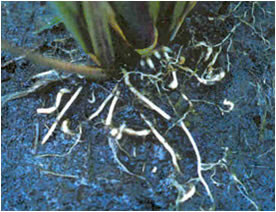 |
| Non insect pest | Symptom of Damage |
Advisory |
Image |
Crab: Pradelphusa hydrodromus
|
• Crab burrow on the sides of the bunds and live.
• Cut the young paddy plants near the ground level and carry them to their burrows for feeding.
• They are active during night; as they are nocturnal.
• Besides damaging crop, they make a series of burrow in paddy fields due to which water is not retained in the field.
|
• Application of FYM at the time of puddling.
• Block the mud holes on the farm bunds and mix paste of Silk Cotton (Bombax ceiba) tree bark, Embelia ribes fruits and Asafoeitda 2 kg each in 100 lit water in 1 ha.
• Fumigate the burrows with the cyanogas dust.
• Poison baiting of 0.5% parathion with rice syrup at the rate of 80-100 ml per burrow. |
|
| Non insect pest | Symptom of Damage |
Advisory |
Image |
Mite: Oligonychus oryzae
|
• Both the adults and young ones remain in large numbers on the lower side and suck the juice.
• Infested plants look pale and loss of chlorophyll on the leaves become dirty brown colour.
• Appearence of white patches as a result of desapping.
• Seedling in the nurseries and transplanted crop are affected. |
• Plough the stubble after harvesting the crop.
• Fallowing of fields, rotation with an alternate crop.
• Cleaning machinery before using in an un-infested field
• Sampling 15 days after planting to catch mite populations at low levels, and avoidance of second-cropping.
• Apply systemic miticides.
• Effective acaricide – Spiromesifen at 72 g a.i/ha.
• Predatory mites may have the ability to suppress populations. |
|
| Non insect pest | Symptom of Damage |
Advisory |
Image |
Rats: 1. Lesser bandicoot / mole rat / field rat, Bandicota bengalensis |
• Chopped young seedlings
• Irregular cuttings of stem
• Patches of depressions seen in the field at early stage
• Chewed developing buds or ripening grains
• Tillers cut near base at 45° angle. Cut tillers may be seen in patches.
• At ripening stage, the ear heads are cut and stored in the burrows. |
• Physical control includes hunting, rat drives, digging, and exclusion.
• Narrow bund maintenance (45 × 30 cm).
• Digging burrows and kille the rats during the off season, poison baiting with zinc phosphide or bromadiolone 3 to 4 weeks after planting, and setting up of Thanjavur or bamboo bow traps (100 nos/ha) are to be followed in sequence.
• Locate the burrows opened by the rats and insert two pellets each of 0.5 or 0.6g of aluminium phosphide per burrow as deep into the burrow as possible and plug the entrance with a mud ball.
• Poison bait at 1 part zinc phosphide with 49 parts popped corn/rice/dry fish or bromodialone 0.25 w/w (1:49) at 0.005%. Mix one part of bromodialone + 49 parts of bait and keep inside the field.
• Warfarin 0.5% 1 part with 19 parts of popped corn/rice/dry fish and keep in field.
• Setting up of owl perches at 40 -50/ha.
|
|
| Non insect pest | Symptom of Damage |
Advisory |
Image |
| Golden apple Snail: Pomacea canaliculata | • Missing seedlings/hills
• Floating of cut leaves
• Cut stems
• Decreased plant stand
• Sparse or uneven stand |
Cultural method
• Planting older seedlings, planting at higher densities, or planting on ridges above the water line.
• Proper leveling of field.
• practice off-season tillage to crush snails and expose them to sun.
• Ensure proper drainage to field.
• Crop rotation with a dryland crop and allow the land fallow for some period.
• Construct canalets along bunds and inside paddyfield for easy drainage and collection of snails.
• Atractants like newspaper can be used.
• Good water management by proper levelling for the first two weeks is recommended.
Mechanical method
• Install screens with 5 mm mesh at water inlets to minimize the entry of snails into the rice fields and facilitate collection by hand.
• Handpicking and crushing, staking with bamboo or other wooden stakes before and after transplanting to facilitate egg mass collection.
• Use of a hand-operated device to smash egg clusters between two snail egg clappers.
Biological method
• Use of fishes like common carp, Japanese crucian, heron, and weasels as biological control agents.
• A firefly nymph is also act as effective natural enemy for snail.
• Herding ducks and raising fish in the paddy field.
• Birds prey on both eggs and neonates. Rats and snakes also feed on them.
Chemical method
|
|
| Panicle Formation |
| Insect Pests | Symptom of Damage |
Advisory |
Image |
| Brown plant leafhopper: Nilaparvata lugens | • Nymphs and adults congregate at the base of the plant above the water level and suck the sap
• Affected plant dries up and gives a scorched appearance called "hopper burn".
• Circular patches of drying and lodging of matured plant
• It is a vector of grassy stunt, ragged stunt and wilted stunt diseases |
• Use resistant/tolerant varieties like Aruna, ADT 36, Co 42, Co 46 IR 36, IR 72.
• Avoid close planting.
• Provide 30 cm rogue spacing at every 2.5 m to reduce the pest incidence.
• Avoid use of excessive nitrogenous fertilizers.
• Control irrigation by intermittent draining.
• Set up light traps during night.
• Set up Yellow pan traps during day time.
• Conserve natural enemies like spider Lycosa pseudoannulata, Cyrtorhinus lividipennis.
• Avoid synthetic pyrethroids, methyl parathion, fenthion and quinalphos causes resurgence of this pest
• Drain the water before the spraying insecticides.
• Apply any one of the following insecticides: Phosphamidon 40 SL@ 1000 ml/ha; Monocrotophos 36 SL @ 1250 ml/ha; Carbofuran 3 G @ 17.5 kg/ha; Imidacloprid 18.5@ 100 ml/ha; Thiomethoxam 20 WDG@ 100 ml/ha; Dichlorvos 76 WSC @ 350 ml/ ha; Neem oil 3% @ 15 lit/ha; Iluppai oil 6% @ 30 lit/ha; Neem seed kernel extract 5% @ 25 kg/ha
|
|
| Insect Pests | Symptom of Damage |
Advisory |
Image |
| White backed plant hopper: Sogatella furcifera | • Suck the sap and cause stunted growth.
• 'Hopper burn' is caused in irregular patches. |
Cultural control: • Avoid use of excessive nitrogenous fertilizers
• Control irrigation by intermittent draining
• Use varieties released by IRRI, which contain genes for WBPH resistance, like IR26, IR64, IR36, IR56, and IR72.
• Avoid close planting and provide 30 cm rogue spacing at every 2.5 to 3.0 m to reduce the pest incidence.
• Set up light traps during night
• Use yellow pan traps during day time
• WBPH population can be regulated by natural biological control agents
• Release egg parasitoid Anagrus sp and adults and nymphs of Pachygonatopus sp.
• Conserve Coccinellid beetles, staphylinid beetles, carabid beetles, hydrophilid, dytiscid beetles, dragonflies, damselflies, wasps, lygaeid bugs, Predatory mites and spiders search the plant for WBPH nymphs and adults.
Economic threshold level
1 hopper/ tiller in the absence of predatory spider and 2 hoppers /tiller when spider is present at 1/hill.
Spray any one of the following insecticide
• Phosphamidon 40 SL@ 1000 ml/ha
• Monocrotophos 36 SL @ 1250 ml/ha
• Carbofuran 3 G @ 17.5 kg/ha
• Dichlorvos 76 WSC @ 350 ml/ ha
Use botanicals
• 3-5 % Andrographis paniculata kashaayam
• Garlic, ginger,chilli extract
• Neem oil 3% @ 15 lit/ha
• Iluppai oil 6% @ 30 lit/ha
• Neem seed kernel extract 5% @ 25 kg/ha |
|
| Insect Pests | Symptom of Damage |
Advisory |
Image |
| Thrips: Stenchaetothrips biformis | • It causes damage both in nursery and main field.
• Both the adults and nymphs lacerate the tender leaves and suck up the plant sap.
• Yellow (or) silvery streaks on the leaves of young seedlings.
• Terminal rolling and drying of leaves from tip to base.
• Damaged leaves roll inwards along the margins, feeding causes leaf drying resulting poor crop growth.
• The damage is severe under water stress conditions. |
Cultural control
• Submerge infested crops intermittently for 1-2 days.
• Drag a wet cloth on the seedlings.
• Flooding to submerge the infested field for 2 days as a cultural control practice is very effective against the rice thrips.
• There are identified cultivars with known resistance to the rice thrips.
• Use resistant/tolerant varieties
Biological control
• Predatory thrips, coccinellid beetles, anthocorid bugs, and staphylinid beetles are biological control agents that feed on both the nymph and adults.
Chemical control
ETL Sampling: Wet your palm with water and pass over the foliage in 12 places in the nursery. If thrips population exceeds 60 numbers in 12 passes or if rolling of 1/2 area of first and 2nd leaves in 10% of seedlings is noticed
• Phosphamidon 40 SL @ 300 ml
• Monocrotophos 36 SL @ 300 ml |
|
| Insect Pests | Symptom of Damage |
Advisory |
Image |
| Green Leafhopper: Nephotettix virescens | • Yellowing of leaves from tip to downwards.
• GLH have their effects primarily during the seedling to panicle initiation stages of crop growth.
• Plant stunted with reduced vigor
• Number of productive tillers reduced
• Withering or complete drying of plant
• feed on rice by sucking the plant sap
• plugging the vascular bundles with stylet sheaths
• white or pale yellow eggs inside leaf sheaths or midribs
• yellow or pale green nymphs with or without black markings
• pale green adults feeding on upper parts of the crop
• Vector for the diseases and Transmits virus diseases such as Tungro, yellow dwarf, yellow-orange leaf, and transitory yellowing
|
• The most effective means of GLH management is to use GLH-resistant and tungro-resistant varieties like IR 50, IR 54 ,IR 64, CR 1009, PY 3,Co 46 and white ponni .
• Apply neem cake @ 12.5 kg/20 cent nursery as basal dose
• Reducing the number of rice crops to two per year and synchronized crop establishment across farms reduces leafhoppers and other insect vectors.
• Transplanting older seedlings (>3 weeks) reduces viral disease susceptibility transmitted by
• Early planting within a given planting period,particularly in the dry season, reduces the risk of
• Avoid planting during the peak of GLH activity to avoid infestation.
• Light traps can be used to show GLH numbers.
• Nitrogen should be applied as needed to avoid contributing to population or hindering plant recovery from planthopper damage by applying insufficient nitrogen.
• Good weed control in the field and on the bunds removes the preferred grassy hosts of GLH and promotes crop vigor.
• Crop rotation with a non-rice crop during the dry season decreases alternate hosts for diseases.
• Upland rice intercropped with soybean reduces the incidence of leafhoppers on rice compared to rice alone
• Various parasitoids attack the GLH eggs, while predators and pathogens can also control GLH.
The major egg parasitoids are: Oligosita yasumatsui (Hymenoptera: Trichogrammatidae); Anagrus spp. (Hymenoptera: Mymaridae); Gonatocerus spp. (Hymenoptera: Mymaridae).
• The most abundant predator is the green mired bug Cyrtorhinus lividipennis: which predate on both eggs and nymphs.
• Conserve bological control agents viz., small wasps parasitize the eggs, strepsipterans, small wasps, pipunculid flies, and nematodes parasitize both the nymphs and adults. They are also attacked by aquatic veliid bugs, nabid bugs, empid flies, damselflies, dragonflies, and spiders.
ETL: 60/25 net sweeps or 5/hill at vegetative stage or 10/hill at flowering or 2/hill in tungro endemic area
• Scout the field for the presence of Tungro and GLH. Check 20 hills while walking diagonally across a transplanted field.
• Direct control may be required if there are more than 5 GLH per hill, although if tungro is present, even 2 GLH per hill can seriously damage a crop.
•Spray any one of the following: Spray insecticides twice, 15 and 30 days after transplanting
Fenitrothion 50 EC 80 ml (or) Phosphamidon 40 SL 50 ml (or) Fenthion 100 EC 40 ml (or) Quinalphos 25 EC 80 ml (or) Phosalone 35 EC 120 ml (or) Endosulfan 35 EC 80 ml (or) Monocrotophos 36 SL 40 ml
Maintain 2.5 cm of water in the nursery and broadcast anyone of the following in 20 cents Carbofuran 3 G 3.5 kg (or) Phorate 10 G 1.0 kg (or) Quinalphos 5 G 2.0 kg
|
|
| Insect Pests | Symptom of Damage |
Advisory |
Image |
| Stem borer: Scirpophaga incertulas | • Caterpillar bore into central shoot of paddy seedling and tiller
• At vegetative stage it causes drying of the central shoot known as "dead heart"
• Whole field exhibits whitish scorched appearance at severe infestation.
• Leaves are folded, rolled and often webbed together with white patches on them. |
Cultural methods
• Monitoring the field during the vulnerable crop growth stages for early detection of dead hearts and white ear.
• Removal and proper disposal of crop stubbles after harvesting.
• Grow resistant varieties like Ratna,, TKM 6, IR 20 , IR 40, IR 56, ADT 47, ADT 48, ASD 20, IR 36, ADT 44, PY 4, ADT 46, Madhu, Kanchana, Swarnapraba, karthika, Deepthi and Tellahamsa.
• Clip the tip of the seedlings before transplanting to eliminate egg masses.
• Collect and destroy the egg masses.
• Avoid close planting and continuous water stagnation at early stages.
• Pull out and destroy the affected tillers.
• Harvest the crop up to the ground level and plough the field immediately after the harvest to destroy borer population.
Mechanical methods:
Set up 1 light trap/5 ha to attract and kill the moths; Install bird perches to encourage bird predators; Use sex pheromone: Monitor through pheromone traps (@ 10 to 12/ha) for timely control measures. Change the lure at 15-20 days intervals.
Biological methods:
• Release of egg parasitoid Trichogramma japonicum thrice at weekly interval from 28 days after transplanting @ 5 cc (1 lakh egg parasitoids)/ha/release. followed by the release of Trichogramma japonicum at 35 and 42 DAT.
• Apply Bacillus thuringiensis var kurstaki at 2.5 kg/ha to reduce the oviposition by the stem borer.
• Release the egg cards in field during morning hours, Avoid spraying of chemicals on 3 days before and upto seven days after field release of egg cards and Tie the egg cards under the leaf surface.
Chemical methods
ETL: 2 egg masses/m2 (or) 10% dead heart at vegetative stage (or) 2% White ear at Flowering stage.
• Spray 2 rounds of quinalphos or phosphomidon at 1000ml/ha at 7 days interval to manage newly hatched larvae.
Eco friendly methods
Use of Botanicals: Spray neem seed kernel extract 5% (25 kg/ha) to reduce the oviposition by the stem borer.
|
|
| Insect Pests | Symptom of Damage |
Advisory |
Image |
| Leaf folder: Cnaphalocrocis medinalis | • Leaves folded longitudinally, rolled and often webbed together with white patches on them indicating the areas fed by caterpillar and larvae remain inside.
• Larvae scrape the green tissues of the leaves and become white and dry.
• During severe infestation the whole field exhibits whitish scorched appearance. |
Cultural method
• Cultivate resistant varieties like, Cauveri, Akashi, TKM 6, TKM 12, ADT 46,TPS 2,TPS 3, ADT 44,PY 4, Kairali, Ahalya, Kunju Kunju varna, kunju kunju priya, Reshmi (PTB 44), Neeraja(PTB 47) and Deepthi.
• Keep the bunds clean by trimming and removing the grassy weeds.
• Avoid excessive nitrogenous fertilizers.
• Don't use carbofuran (or) phorate granules to avoid resurgence of pests.
• Clip the leaves of affected plants.
• Pass rope across the field to dislodge the leaf feeding larvae.
• Open up the leaf folds with the help of a thorny twig.
Trap method
• Set up light trap at least 1 for 5 ha to attract and kill the moths.
• Set up bird perches (40 to 50/ha) for insectivorous Birds at vegetative phase of crop.
• Monitor through pheromone traps (@ 10 to 12/ha for timely control measures. Change the lure at 15-20 days intervals.
Biological method
• Release Trichogramma chilonis (Egg Parasitoids) thrice on 37, 44 and 51 Days After Transplanting (DAT) @ 5 cc (1 lakh egg parasitoids)/ha/release.
• Release egg cards in field during morning hours and tie the egg cards under the leaf surface.
• Avoid spraying of chemicals on 3 days before and upto seven days after field release of egg cards.
Ecofriendly method:
Preserve natural enemies and predators
Natural enemies: Ichneumonid wasp-Trichomma cnaphalocrosis and Itoplectis narangae
Release of mirid bug Cytorhinus lividipennis @ 50 – 75 egg/ m2
Damselfly – Agriocnema pygmae; Cricket – Anaxipha longipennis and Metioche vittaticollis; Lady bird beetle – Micraspis crocera
Botanicals:
• Spray Neem seed kernel extract 5% @ 25 kg/ha (or) Neem Oil 3% .
• Spray Nimbicidin – 500 ml/ha
Chemical method:
ETL- 10% leaf damage at vegetative phase and 5% of flag leaf damage at flowering |
|
| Non insect pest | Symptom of Damage |
Advisory |
Image |
| White tip nematode: Aphelenchoides besseyi | • Feeding at leaf tips results in whitening of the top 3-5 cm of the leaf, leading to necrosis known as "White Tip".
• Tips of developing leaves become twisted and crinkled.
• Diseased plants are stunted, lack vigor and produce small panicles.
• Affected panicles show high sterility, distorted glumes and small and distorted kernels. In extreme cases the affected grains become chaffy.
• When nematode carrying seeds are sown, the immature forms become active, move up the plant along a thin film of moisture and feed on the foliage ectoparasitically. |
• Resistant varieties such as TPS 1, TPS 2 can be grown.
• Presoaking overnight and sun drying for 12 hours at 6 hrs/day for two days, two or three days prior to sowing to denematize the seeds.
• Hot water treatment of seed with 52 -53 degree C for 15 minutes can be used to destroy this nematode infecting the seeds.
• Apply carbofuran 3G in nursery @ 1.0 kg a.i/ha 7 days before transplanting.
• Apply cartaphydrochloride @ 1.0 kg a.i/ha at 45 DAT
• Aphelenchoides besseyi infestations can be avoided by using nematode-free seeds and planting in nematode-free planting material.
• Destruction of infected source of inoculum like seeds,weeds,debris left after harvest in field.
• Chemical treatments of seed with Benomyl or Thiabendazole is being effective in controlling nematodes.
• Spraying of infested crop with Parathion (.025%) and Trichlorophos (0.03%) three times has been found to be effective. |
|
| Non insect pest | Symptom of Damage |
Advisory |
Image |
Root knot nematode: Meloidogyne graminicola
|
• Characteristic hooked-like galls on roots.
• Newly emerged leaves appear distorted and crinkled along the margins.
• Chlorosis and Stunting of plants.
• Heavily infected plants flower and mature early.
• Reduction in number of tillers.
• Size of the ear head is reduced with reduced number of grains.
|
• Cultural control includes continuous flooding, raising the rice seedlings in flooded soils, and crop rotation.
• Soil solarization with 50 – 100µ clear polythene sheets for 3 weeks before preparation of fields.
• Bare fallow period and planting cover crops such as sesame and cowpea.
• Follow crop rotation with marigold (Tagetes sp.).
• Cultivate resistant varieties such as IR cultivars.
• Follow soil drenches and seedling root dips or seed soaks with nematicides.
• Seed treatment with EPN and carbofuran.
• Adopt root dipping in systemic chemicals such as oxamyl or fensulfothion, phorate, carbofuran, and DBCP.
• Soil injection of Telone into the soil before planting. |
 |
| Non insect pest | Symptom of Damage |
Advisory |
Image |
Crab: Pradelphusa hydrodromus
|
• Crab burrow on the sides of the bunds and live.
• Cut the young paddy plants near the ground level and carry them to their burrows for feeding.
• They are active during night; as they are nocturnal.
• Besides damaging crop, they make a series of burrow in paddy fields due to which water is not retained in the field.
|
• Application of FYM at the time of puddling.
• Block the mud holes on the farm bunds and mix paste of Silk Cotton (Bombax ceiba) tree bark, Embelia ribes fruits and Asafoeitda 2 kg each in 100 lit water in 1 ha.
• Fumigate the burrows with the cyanogas dust.
• Poison baiting of 0.5% parathion with rice syrup at the rate of 80-100 ml per burrow. |
|
| Non insect pest | Symptom of Damage |
Advisory |
Image |
Mite: Oligonychus oryzae
|
• Both the adults and young ones remain in large numbers on the lower side and suck the juice.
• Infested plants look pale and loss of chlorophyll on the leaves become dirty brown colour.
• Appearence of white patches as a result of desapping.
• Seedling in the nurseries and transplanted crop are affected. |
• Plough the stubble after harvesting the crop.
• Fallowing of fields, rotation with an alternate crop.
• Cleaning machinery before using in an un-infested field
• Sampling 15 days after planting to catch mite populations at low levels, and avoidance of second-cropping.
• Apply systemic miticides.
• Effective acaricide – Spiromesifen at 72 g a.i/ha.
• Predatory mites may have the ability to suppress populations. |
|
| Non insect pest | Symptom of Damage |
Advisory |
Image |
Rats: 1. Lesser bandicoot / mole rat / field rat, Bandicota bengalensis |
• Chopped young seedlings
• Irregular cuttings of stem
• Patches of depressions seen in the field at early stage
• Chewed developing buds or ripening grains
• Tillers cut near base at 45° angle. Cut tillers may be seen in patches.
• At ripening stage, the ear heads are cut and stored in the burrows. |
• Physical control includes hunting, rat drives, digging, and exclusion.
• Narrow bund maintenance (45 × 30 cm).
• Digging burrows and kille the rats during the off season, poison baiting with zinc phosphide or bromadiolone 3 to 4 weeks after planting, and setting up of Thanjavur or bamboo bow traps (100 nos/ha) are to be followed in sequence.
• Locate the burrows opened by the rats and insert two pellets each of 0.5 or 0.6g of aluminium phosphide per burrow as deep into the burrow as possible and plug the entrance with a mud ball.
• Poison bait at 1 part zinc phosphide with 49 parts popped corn/rice/dry fish or bromodialone 0.25 w/w (1:49) at 0.005%. Mix one part of bromodialone + 49 parts of bait and keep inside the field.
• Warfarin 0.5% 1 part with 19 parts of popped corn/rice/dry fish and keep in field.
• Setting up of owl perches at 40 -50/ha.
|
|
| Non insect pest | Symptom of Damage |
Advisory |
Image |
| Golden apple Snail: Pomacea canaliculata | • Missing seedlings/hills
• Floating of cut leaves
• Cut stems
• Decreased plant stand
• Sparse or uneven stand |
Cultural method
• Planting older seedlings, planting at higher densities, or planting on ridges above the water line.
• Proper leveling of field.
• practice off-season tillage to crush snails and expose them to sun.
• Ensure proper drainage to field.
• Crop rotation with a dryland crop and allow the land fallow for some period.
• Construct canalets along bunds and inside paddyfield for easy drainage and collection of snails.
• Atractants like newspaper can be used.
• Good water management by proper levelling for the first two weeks is recommended.
Mechanical method
• Install screens with 5 mm mesh at water inlets to minimize the entry of snails into the rice fields and facilitate collection by hand.
• Handpicking and crushing, staking with bamboo or other wooden stakes before and after transplanting to facilitate egg mass collection.
• Use of a hand-operated device to smash egg clusters between two snail egg clappers.
Biological method
• Use of fishes like common carp, Japanese crucian, heron, and weasels as biological control agents.
• A firefly nymph is also act as effective natural enemy for snail.
• Herding ducks and raising fish in the paddy field.
• Birds prey on both eggs and neonates. Rats and snakes also feed on them.
Chemical method
|
|
| Seedling stage at Nursery |
| Disease | Symptom of Damage |
Advisory |
Image |
Rice blast: Pyricularia oryzea
|
• Disease can infect paddy at all growth stages and all aerial parts of plant (Leaf, neck and node).
• Small specks originate on leaves - subsequently enlarge into spindle shaped spots(0.5 to 1.5cm length, 0.3 to 0.5cm width) with ashy center.
• Several spots coalesce and form big irregular patches |
• Avoid excess N - fertilizer application.
• Cultivate tolerant varieties like Palghuna, Swarnamukhi, Swathi, Prabhat, Co 47, IR - 64, IR - 36 and Jaya.
• Dry seed treatment with Pseudomonas fluorescens talc formulation @10g/kg of seed.
• Stagnate the water to a depth of 2.5cm in the nursery.
• Sprinkle 2.5 kg of P. fluorescens (talc) and mix with stagnated water.
• Soak the roots of seedlings for 30 min before transplanting.
• Treat the seeds with Captan or Carbendazim or Thiram or Tricyclazole @ 2.0 g/kg seed.
• Spray Tricyclazole at 1g/lit of water or Edifenphos at 1 ml/lit of water or Carbendazim at 1.0 gm/lit. |
|
| Disease | Symptom of Damage |
Advisory |
Image |
Brown spot Drechslera oryzae (Cochliobolus miyabeanus)
|
• Blight of seedlings
• Isolated brown, round to oval (resemble sesame seed) spots and coalesce to form large patches. |
• Use of tolerant varieties (Co 20, IR – 24 and Padma) and disease free seeds.
• Seed soak / treatment with Captan or Thiram at 2.0g /kg of seed.
• Spray Mancozeb (2.0g/lit) or Edifenphos (1ml/lit). |
|
| Disease | Symptom of Damage |
Advisory |
Image |
Rice Tungro virus disease
(i)Rice tungro Bacilliform virus
(ii) Rice tungro Spherical virus
Vector : Green leaf hopper |
• Stunting and reduced tillering.
|
• Set up light traps to monitor and attract vectors.
|
| Planting to tillering |
| Disease | Symptom of Damage |
Advisory |
Image |
| Blast | • All above ground parts such as leaves, leaf collar, culm, culm nodes, neck, and panicle are attacked.
• Initial symptoms are white to gray-green lesions or spots with brown borders.
• Small specks originate on leaves and subsequently enlarge into spindle shaped spots(0.5 to 1.5cm length, 0.3 to 0.5cm width) with ashy center.
• Older lesions elliptical or spindle-shaped and whitish to gray with necrotic borders, several spots coalesce to form big irregular patches.
• Nodal infection causes the culm to break at the infected node.
• Internodal infection occurs at base of the plant which causes white panicles similar to that of yellow stem borer infection or water deficit.
• Lesions on the neck are grayish brown and cause girdling of neck and falling of panicle.
• If infection of the neck occurs before milk stage, no grain is formed, but if infection occurs later, grains of poor quality are formed.
• Lesions on the branches of the panicles and on the spikelet pedicels are brown to dark brown.
• The size and shape of the spots vary on different rice varieties.
Leaf Blast
• Severe cases of infection - entire crop give a blasted or burnt appearance- hence the name "BLAST"
• Severe cases - lodging of crop (after ear emergence).
Neck Blast
• Neck region of panicle develops a black color and shrivels completely / partially grain set inhibited, panicle breaks at the neck and hangs.
Nodal Blast: Nodes become black and break up
|
Cultural method
• Cultivate resistant varieties/ tolerant varieties like Co 47, Co 50, ADT 36, ADT 37, ASD 16, ASD 20, ADT 39, ASD 19,TPS 3, White ponni, ADT 44, BPT 5204, CoRH , Palghuna, Swarnamukhi, Swathi, Prabhat, IR - 64, , IR – 36 and Jaya.
• Avoid excess Nitrogenous fertilizer application and apply nitrogen in three split doses.
Preventive method
• Avoid dry nurseries and late planting.
• Burn the straw and stubbles after harvest
• Avoid grasses and other weeds on bunds and inside the field.
• Dry seed treatment with Pseudomonas fluorescens talc formulation @10g/kg of seed.
• Stagnate water to a depth of 2.5cm over an area of 25m2 in the nursery.
• Sprinkle 2.5 kg of P. fluorescens (talc) and mix with stagnated water.
after transplanting at 10 day intervals, three times.
Chemical method
• Do not apply lower/higher doses of fungicides.
• Spray before 11.00 AM/after 3.00 PM. and avoid noon hours for spraying.
• Seed treatment at 2.0 g/kg seed with Captan or Carbendazim or Thiram or Tricyclazole.
• Systemic fungicides such as pyroquilon and tricyclazole.
• Spraying of Tricyclazole at 1g/lit of water or Edifenphos at 1 ml/lit of water or Carbendazim at 1.0 gm/lit.
• 3 to 4 sprays each at nursery, tillering stage and panicle emergence stage may be required for complete control.
Panicle initiation to booting: At 2 to 5% leaf area damage- spray Edifenphos or Carbendazim or Tricyclazole @ 1.0 gm/lit. |
|
| Disease | Symptom of Damage |
Advisory |
Image |
Brown spot: Helminthosporium oryzae
|
• Also known as sesame leaf spot or Helminthosporiose or fungal blight
• The fungus attacks the crop from seedling in nursery to milk stage in main field.
• Appears first as minute brown dots, later becoming cylindrical or oval to circular.(resemble sesame seed) and spots measures 0.5 to 2.0mm in breadth - coalesce to form large patches.
• Several spots coalesce and the leaf dries up.
• Infection also occurs on panicle, neck with brown colour appearance
• Seeds also infected (black or brown spots on glumes spots are covered by olivaceous velvety growth)
• Death of seedlings and affected nurseries recognized from a distance by their brownish scorched appearance.
• Dark brown or black spots also appear on glumes.
• The infection of the seed causes failure of seed germination, seedling mortality and reduces the grain quality and weight.
• 50% yield reduction in severe cases .
|
Preventive method
• Seed treatment with Pseudomonas fluorescens @ 10g/kg of seed followed by seedling dip @ of 2.5 kg products/ha dissolved in 100 litres and dipping for 30 minutes.
• Seed soak / seed treatment with Captan or Thiram at 2.0g /kg of seed
• Seed treatment with Agrosan or Ceresan 2.5 g/kg seed to ward off seedling blight stage
• Since the fungus is seed transmitted, Follow hot water seed treatment (53-54°C) for 10-12 minutes may be effective before sowing. This treatment controls primary infection at the seedling stage. Presoaking the seed in cold water for 8 hours increases effectivity of the treatment.
Cultural method
• As disease is seed borne, use disease free seeds.
• Removal of alternate & collateral hosts.
• Grow resistant varieties like ADT 44, PY 4,CoRH 1, Co 44,CAUVERY,BHAVANI,TPS 4 and Dhanu.
• The disease is rarely observed in normally fertile rice soils, provide proper nutrition for optimum plant growth and prevent water stress.
• Soils with low available silicon should be amended with calcium silicate slag before planting and the field should be well irrigated to avoid water stress.
Chemical method
• Soak the seeds / seed treatment with Captan or Thiram at 2.0g /kg of seed
• Spray Mancozeb (2.0g/lit) or Edifenphos (1ml/lit) - 2 to 3 times at 10 - 15 day intervals.
• Spray preferably during early hours or afternoon at flowering and post - flowering stages.
• Seed treatment with Agrosan or Ceresan 2.5 g/kg seed to control seedling blight
• Spraying copper fungicides to control secondary spread of the disease.
• Grisepfulvin, nystatin, aureofungin, and similar antibiotics found effective in preventing primary seedling infection.
• Seed treatment with captan, thiram, chitosan, carbendazim, or mancozeb has been found to reduce seedling infection.
• Seed treatment with tricyclazole followed by spraying of mancozeb + tricyclazole at tillering and late booting stages. |
|
| Disease | Symptom of Damage |
Advisory |
Image |
sheat blight: Rhizoctonia solani
|
• The fungus affects the crop from tillering to heading stage.
• Initial symptoms are noticed on leaf sheaths near water level.
• On the leaf sheath oval or elliptical or irregular greenish grey spots are formed.
• As the spots enlarge, the centre becomes greyish white with an irregular blackish brown or purple brown border.
• Lesions on the upper parts of plants extend rapidly coalesing with each other to cover entire tillers from the water line to the flag leaf.
• The presence of several large lesions on a leaf sheath usually causes death of the whole leaf, and in severe cases all the leaves of a plant may be blighted in this way.
• The infection extends to the inner sheaths resulting in death of the entire plant.
• Older plants are highly susceptible.
• Five to six week old leaf sheaths are highly susceptible.
• Plants heavily infected in the early heading and grain filling growth stages produce poorly filled grain, especially in the lower part of the panicle.
• A yield loss of 25% was reported if the flag leaves are infected.
|
Cultural method
• Apply FYM 12.5 t/ha or green manure 6.25 t/ha to promote antagonistic microflora
• Avoid excess doses of fertilizers.
• Adopt optimum spacing.
• Eliminate weed hosts.
• Apply organic amendments.
• Avoid flow of irrigation water from infected fields to healthy fields.
• Deep ploughing in summer and burning of stubbles.
Preventive method
• Seed treatment with Pseudomonas fluorescens @ of 10g/kg of seed followed by seedling dip @ of 2.5 kg or products/ha dissolved in 100 litres and dipping for 30 minutes.
• Soil application of P.fluorescens @ of 2.5 kg/ha after 30 days of transplanting (This product should be mixed with 50 kg of FYM/Sand and then applied.
• Foliar spray of Pseudomonas fluorescens at 0.2% concentration ,commencing from 45 days after transplanting at 10 days interval for 3 times depending upon the intensity of disease.
Chemical method
• Carbendazim (1 g/lit), Propiconazole (1ml/lit).
• Spraying of infected plants with fungicides, such as Benomyl and Iprodione, and antibiotics, such as Validamycin and Polyoxin, is effective against the disease
• Spray Carbendazim 250 g or Chlorothalonil 1 kg or Edifenphos 1 lit/ha. |
|
| Disease | Symptom of Damage |
Advisory |
Image |
Sheath rot: Sarocladium oryzae
|
• Discoloration of flag leaf sheath.
• Rotting of leaf sheath that encloses the young panicles.
• Irregular spots or lesions, with dark reddish brown margins and gray center discoloration in sheath.
• Lesions enlarge and often coalesce and may cover entire leaf sheath.
• Severe infection causes entire or parts of young panicles to remain within the sheath.
• Unemerged panicles rot and florets turn reddish-brown to dark brown.
• Whitish powdery growth inside the affected sheaths and young panicles.
• Infected panicles and grains are sterile, shriveled, partially or unfilled, and discolored.
• The disease is important during the heading towards the maturity stages of the rice crop.
Confirmation
• Lesions develop on the uppermost leaf sheaths that enclose the panicles.
• Some panicles do not emerge or emerge partially.
• Rotting of sheath and development of whitish powdery fungal growth. |
Cultural method
• Remove infected stubbles after harvest .
• Maintain optimum plant spacing.
• Application of potash at tillering stage.
• Control weeds and maintain field sanitation.
Preventive method
• Seed treatment with Pseudomonas fluorescens @ of 10g/kg of seed followed by seedling dip @ of 2.5 kg or products/ha dissolved in 100 litres and dipping for 30 minutes.
• Soil application of P.fluorescens @ of 2.5 kg/ha after 30 days of transplanting (This product should be mixed with 50 kg of FYM/Sand and then applied.
• Foliar spray at 0.2% concentration Pseudomonas fluorescens at 45 days after transplanting at 10 days interval for 3 times based on intensity of disease.
Chemical method
• Spray fungicides at the time of panicle emergence.
• Spray Ediphenphos with high volume sprayers.
• Application of a systemic pesticide, Tridemorph (a fungicide) and phosphamidon (an insecticide).
• Seed treatment with Mancozeb and Benomyl to eliminate seed borne inoculum.
• Foliar spraying of carbendazim, edifenphos, or mancozeb at booting stage.
• Spray Carbendazim 250 g or Chlorothalonil 1 kg or Edifenphos 1 lit/ha.
• Foliar spraying with Benomyl and copper oxychloride. |
|
| Disease | Symptom of Damage |
Advisory |
Image |
Bacterial Leaf Blight: Xanthomonas oryzae pv. oryzae
|
Seedling wilt or kresek
• Observed 1-3 weeks after transplanting.
• Green water-soaked layer along the cut portion or leaf tip of leaves as early symptom.
• Leaves wilt and roll up and become grayish green to yellow.
Leaf blight
• Water-soaked to yellowish stripes on leaf blades or starting at leaf tips with a wavy margin.
• Leaves with undulated yellowish white or golden yellow marginal necrosis, drying of leaves back from tip and curling, leaving mid rib intact.
• Appearance of bacterial ooze that looks like a milky or opaque dewdrop on young lesions early in the morning.
• Severely infected leaves tend to dry quickly.
Confirmation
• To distinguish kresek symptoms from stem borer damage, the lower end of the infected seedling can be squeezed between the fingers.
• Yellowish bacterial ooze may be seen coming out of the cut ends.
• Observe the cut portion against the light to see the bacterial ooze streaming out from the cut ends into the water.
• Water becomes turbid after 1-2 hour. |
Cultural method
• Grow Tolerant varieties like IR 20, IR 72, Ponmani and TKM 6.
• Use disease free seed.
• Grow nurseries preferably in isolated upland conditions.
• Avoid clipping of seedlings during transplanting.
• Balanced fertilization, avoid excess N – application.
• Skip N - application at booting (if disease is moderate).
• Drain the field (except at flowering stage of the crop).
• Remove weeds and collateral hosts.
• Avoid flow of water from affected fields.
• Maintain proper plant spacing.
|
|
| Disease | Symptom of Damage |
Advisory |
Image |
Tungro: Virus
|
• Stunting and reduced tillering.
Their leaves become yellow or orange-yellow and may have rust-colored spots.
• Discoloration from leaf tip and extends down to the blade or the lower leaf portion
• Delayed flowering, - panicles small and not completely exerted.
• Most panicles sterile or partially filled grains.
• Tungro virus disease affects all growth stages of the rice plant specifically the vegetative stage.
Detection
Collect leaf samples at 6 a.m.
The top 10 cm portion of the leaf is immersed in a solution containing 2 g of iodine and 6 g of potassium iodide in 100 ml of water for 15 minutes or 10 ml of tincture of iodine + 140 ml of water for one hour. Wash the leaves in water and Tungro infected leaves develop dark blue streaks. |
Cultural method
• Cultivate resistant varieties like IR 36, IR 50, ADT 37, Ponmani, Co 45, Co 48, Surekha, Vikramarya, Bharani, IR 36 and white ponni .
• adjust the date of planting to escape from leaf hopper attack.
• Fallowing of field for at least a month to eliminate hosts, viruses and vectors.
• Adopt crop rotation with pulses or oil seeds in epidemic area.
• Apply neem cake @ 12.5 kg/20 cent nursery as basal dose.
• Plouging and harrowing of field to destroy stubbles after harvest to eradicate other tungro hosts. Destruction of weed hosts on bunds.
Trap method
• Set up light traps to monitor and control the vector (Leaf hopper) population.
Chemical method
• Spraying 2 % urea mixed with Mancozeb at 2.5 gm/lit.
• Instead of urea, spray foliar fertilizer like multi-K (potassium nitrate) at 1 per cent which impart resistance due to high potassium content.
• Spray insecticides twice, 15 and 30 days after transplanting to control insect vector
• Spray Two rounds of any one of the following insecticides: Monocrotophos 36 WSC (40 ml/ha) or Fenthion 100 EC (40 ml/ha) may be sprayed 15 and 30 days after transplanting.
• Spray insecticides on vegetation of bunds.
• Maintain 2.5 cm of water in the nursery and broadcast anyone of the following insecticides like Carbofuran 3 G 3.5 kg (or) Phorate 10 G 1.0 kg (or) Quinalphos 5 G 2.0 kg in 20 cents nursery area/ha. |
|
| Disease | Symptom of Damage |
Advisory |
Image |
Leaf streak: Virus
|
• Initially, small, dark-green and water-soaked streaks appears on interveins from tillering to booting stage.
• Streaks progress longitudinally, limited by the veins and soon turn yellow or orange brown.
• Tiny yellow or amber colored droplets bacterial exudates observed along the streaks.
• Streaks coalesce to form large patches and cover the entire leaf surface.
• Lesions turn brown to greyish white then dry when disease is severe.
• Infection in the florets and seeds results in brown or black discoloration and death of ovary, stamens and endosperm and browning of glumes. |
• Proper application of fertilizers and plant spacing, use of resistant varieties (IR 20, TKM 6), and hot water treatment of seeds.
• Practicing field sanitation.
• destroyed Ratoons, straws and volunteer seedlings left on the field after harvest.
• Provide good drainage especially in seedbeds.
• Grow nurseries preferably in isolated upland conditions
• Avoid clipping of seedlings during transplanting.
• Spray fresh cowdung water extract or lemon grass or mint extract at 20%.
• Spraying streptomycin sulphate and tetracycline combination 300g +copper oxychloride 1.25 kg/ha. |
|
| Disease | Symptom of Damage |
Advisory |
Image |
Grassy stunt: Virus
|
• Severe stunting, excessive tillering with upright growth habit.
• Grassy and rosette appearance diseased hills
|
• Avoid close planting and provide 30 cm rogue spacing at every 2.5 to 3.0 m.
|
|
| Disease | Symptom of Damage |
Advisory |
Image |
Ragged stunt: Virus
|
• Severe stunting during early growth stages of the crop.
• Leaves short and dark green with serrated edges.
• Leaf blades twisted at the apex or base, which result in the spiral shape of the leaves.
• Leaf edges uneven and twisted, giving ragged appearance to leaves.
• Ragged portions of the leaves are yellow to yellow-brown
• Vein swellings on leaf blades and sheaths, Swellings are pale yellow or white to dark brown in colour.
• Delayed flowering.
• Incomplete panicle emergence.
|
• Avoid close planting and provide 30 cm rogue spacing at every 2.5 to 3.0 m.
|
|
| Disease | Symptom of Damage |
Advisory |
Image |
Bakanae disease or Foot rot: Gibberella fujikuroi
|
• Infected plants several inches taller than normal plants in seedbed and field as well.
|
• Use disease free well cleaned seeds.
|
|
| Panicle Formation |
| Disease | Symptom of Damage |
Advisory |
Image |
Sheath rot: Sarocladium oryzae
|
• Discoloration of flag leaf sheath.
• Rotting of leaf sheath that encloses the young panicles.
• Irregular spots or lesions, with dark reddish brown margins and gray center discoloration in sheath.
• Lesions enlarge and often coalesce and may cover entire leaf sheath.
• Severe infection causes entire or parts of young panicles to remain within the sheath.
• Unemerged panicles rot and florets turn reddish-brown to dark brown.
• Whitish powdery growth inside the affected sheaths and young panicles.
• Infected panicles and grains are sterile, shriveled, partially or unfilled, and discolored.
• The disease is important during the heading towards the maturity stages of the rice crop.
Confirmation
• Lesions develop on the uppermost leaf sheaths that enclose the panicles.
• Some panicles do not emerge or emerge partially.
• Rotting of sheath and development of whitish powdery fungal growth. |
Cultural method
• Remove infected stubbles after harvest .
• Maintain optimum plant spacing.
• Application of potash at tillering stage.
• Control weeds and maintain field sanitation.
Preventive method
• Seed treatment with Pseudomonas fluorescens @ of 10g/kg of seed followed by seedling dip @ of 2.5 kg or products/ha dissolved in 100 litres and dipping for 30 minutes.
• Soil application of P.fluorescens @ of 2.5 kg/ha after 30 days of transplanting (This product should be mixed with 50 kg of FYM/Sand and then applied.
• Foliar spray at 0.2% concentration Pseudomonas fluorescens at 45 days after transplanting at 10 days interval for 3 times based on intensity of disease.
Chemical method
• Spray fungicides at the time of panicle emergence.
• Spray Ediphenphos with high volume sprayers.
• Application of a systemic pesticide, Tridemorph (a fungicide) and phosphamidon (an insecticide).
• Seed treatment with Mancozeb and Benomyl to eliminate seed borne inoculum.
• Foliar spraying of carbendazim, edifenphos, or mancozeb at booting stage.
• Spray Carbendazim 250 g or Chlorothalonil 1 kg or Edifenphos 1 lit/ha.
• Foliar spraying with Benomyl and copper oxychloride. |
|
| Reprodctive phase stage |
| Panicle formation to Flowering |
| Insect Pests | Symptom of Damage |
Advisory |
Image |
| Brown plant leafhopper: Nilaparvata lugens | • Nymphs and adults congregate at the base of the plant above the water level and suck the sap
• Affected plant dries up and gives a scorched appearance called "hopper burn".
• Circular patches of drying and lodging of matured plant
• It is a vector of grassy stunt, ragged stunt and wilted stunt diseases |
• Use resistant/tolerant varieties like Aruna, ADT 36, Co 42, Co 46 IR 36, IR 72.
• Avoid close planting.
• Provide 30 cm rogue spacing at every 2.5 m to reduce the pest incidence.
• Avoid use of excessive nitrogenous fertilizers.
• Control irrigation by intermittent draining.
• Set up light traps during night.
• Set up Yellow pan traps during day time.
• Conserve natural enemies like spider Lycosa pseudoannulata, Cyrtorhinus lividipennis.
• Avoid synthetic pyrethroids, methyl parathion, fenthion and quinalphos causes resurgence of this pest
• Drain the water before the spraying insecticides.
• Apply any one of the following insecticides: Phosphamidon 40 SL@ 1000 ml/ha; Monocrotophos 36 SL @ 1250 ml/ha; Carbofuran 3 G @ 17.5 kg/ha; Imidacloprid 18.5@ 100 ml/ha; Thiomethoxam 20 WDG@ 100 ml/ha; Dichlorvos 76 WSC @ 350 ml/ ha; Neem oil 3% @ 15 lit/ha; Iluppai oil 6% @ 30 lit/ha; Neem seed kernel extract 5% @ 25 kg/ha
|
|
| Insect Pests | Symptom of Damage |
Advisory |
Image |
| White backed plant hopper: Sogatella furcifera | • Suck the sap and cause stunted growth.
• 'Hopper burn' is caused in irregular patches. |
Cultural control: • Avoid use of excessive nitrogenous fertilizers
• Control irrigation by intermittent draining
• Use varieties released by IRRI, which contain genes for WBPH resistance, like IR26, IR64, IR36, IR56, and IR72.
• Avoid close planting and provide 30 cm rogue spacing at every 2.5 to 3.0 m to reduce the pest incidence.
• Set up light traps during night
• Use yellow pan traps during day time
• WBPH population can be regulated by natural biological control agents
• Release egg parasitoid Anagrus sp and adults and nymphs of Pachygonatopus sp.
• Conserve Coccinellid beetles, staphylinid beetles, carabid beetles, hydrophilid, dytiscid beetles, dragonflies, damselflies, wasps, lygaeid bugs, Predatory mites and spiders search the plant for WBPH nymphs and adults.
Economic threshold level
1 hopper/ tiller in the absence of predatory spider and 2 hoppers /tiller when spider is present at 1/hill.
Spray any one of the following insecticide
• Phosphamidon 40 SL@ 1000 ml/ha
• Monocrotophos 36 SL @ 1250 ml/ha
• Carbofuran 3 G @ 17.5 kg/ha
• Dichlorvos 76 WSC @ 350 ml/ ha
Use botanicals
• 3-5 % Andrographis paniculata kashaayam
• Garlic, ginger,chilli extract
• Neem oil 3% @ 15 lit/ha
• Iluppai oil 6% @ 30 lit/ha
• Neem seed kernel extract 5% @ 25 kg/ha |
|
| Insect Pests | Symptom of Damage |
Advisory |
Image |
| Thrips: Stenchaetothrips biformis | • It causes damage both in nursery and main field.
• Both the adults and nymphs lacerate the tender leaves and suck up the plant sap.
• Yellow (or) silvery streaks on the leaves of young seedlings.
• Terminal rolling and drying of leaves from tip to base.
• Damaged leaves roll inwards along the margins, feeding causes leaf drying resulting poor crop growth.
• The damage is severe under water stress conditions. |
Cultural control
• Submerge infested crops intermittently for 1-2 days.
• Drag a wet cloth on the seedlings.
• Flooding to submerge the infested field for 2 days as a cultural control practice is very effective against the rice thrips.
• There are identified cultivars with known resistance to the rice thrips.
• Use resistant/tolerant varieties
Biological control
• Predatory thrips, coccinellid beetles, anthocorid bugs, and staphylinid beetles are biological control agents that feed on both the nymph and adults.
Chemical control
ETL Sampling: Wet your palm with water and pass over the foliage in 12 places in the nursery. If thrips population exceeds 60 numbers in 12 passes or if rolling of 1/2 area of first and 2nd leaves in 10% of seedlings is noticed
• Phosphamidon 40 SL @ 300 ml
• Monocrotophos 36 SL @ 300 ml |
|
| Insect Pests | Symptom of Damage |
Advisory |
Image |
| Green Leafhopper: Nephotettix virescens | • Yellowing of leaves from tip to downwards.
• GLH have their effects primarily during the seedling to panicle initiation stages of crop growth.
• Plant stunted with reduced vigor
• Number of productive tillers reduced
• Withering or complete drying of plant
• feed on rice by sucking the plant sap
• plugging the vascular bundles with stylet sheaths
• white or pale yellow eggs inside leaf sheaths or midribs
• yellow or pale green nymphs with or without black markings
• pale green adults feeding on upper parts of the crop
• Vector for the diseases and Transmits virus diseases such as Tungro, yellow dwarf, yellow-orange leaf, and transitory yellowing
|
• The most effective means of GLH management is to use GLH-resistant and tungro-resistant varieties like IR 50, IR 54 ,IR 64, CR 1009, PY 3,Co 46 and white ponni .
• Apply neem cake @ 12.5 kg/20 cent nursery as basal dose
• Reducing the number of rice crops to two per year and synchronized crop establishment across farms reduces leafhoppers and other insect vectors.
• Transplanting older seedlings (>3 weeks) reduces viral disease susceptibility transmitted by
• Early planting within a given planting period,particularly in the dry season, reduces the risk of
• Avoid planting during the peak of GLH activity to avoid infestation.
• Light traps can be used to show GLH numbers.
• Nitrogen should be applied as needed to avoid contributing to population or hindering plant recovery from planthopper damage by applying insufficient nitrogen.
• Good weed control in the field and on the bunds removes the preferred grassy hosts of GLH and promotes crop vigor.
• Crop rotation with a non-rice crop during the dry season decreases alternate hosts for diseases.
• Upland rice intercropped with soybean reduces the incidence of leafhoppers on rice compared to rice alone
• Various parasitoids attack the GLH eggs, while predators and pathogens can also control GLH.
The major egg parasitoids are: Oligosita yasumatsui (Hymenoptera: Trichogrammatidae); Anagrus spp. (Hymenoptera: Mymaridae); Gonatocerus spp. (Hymenoptera: Mymaridae).
• The most abundant predator is the green mired bug Cyrtorhinus lividipennis: which predate on both eggs and nymphs.
• Conserve bological control agents viz., small wasps parasitize the eggs, strepsipterans, small wasps, pipunculid flies, and nematodes parasitize both the nymphs and adults. They are also attacked by aquatic veliid bugs, nabid bugs, empid flies, damselflies, dragonflies, and spiders.
ETL: 60/25 net sweeps or 5/hill at vegetative stage or 10/hill at flowering or 2/hill in tungro endemic area
• Scout the field for the presence of Tungro and GLH. Check 20 hills while walking diagonally across a transplanted field.
• Direct control may be required if there are more than 5 GLH per hill, although if tungro is present, even 2 GLH per hill can seriously damage a crop.
•Spray any one of the following: Spray insecticides twice, 15 and 30 days after transplanting
Fenitrothion 50 EC 80 ml (or) Phosphamidon 40 SL 50 ml (or) Fenthion 100 EC 40 ml (or) Quinalphos 25 EC 80 ml (or) Phosalone 35 EC 120 ml (or) Endosulfan 35 EC 80 ml (or) Monocrotophos 36 SL 40 ml
Maintain 2.5 cm of water in the nursery and broadcast anyone of the following in 20 cents Carbofuran 3 G 3.5 kg (or) Phorate 10 G 1.0 kg (or) Quinalphos 5 G 2.0 kg
|
|
| Insect Pests | Symptom of Damage |
Advisory |
Image |
| Stem borer: Scirpophaga incertulas | • Caterpillar bore into central shoot of paddy seedling and tiller
• At vegetative stage it causes drying of the central shoot known as "dead heart"
• Whole field exhibits whitish scorched appearance at severe infestation.
• Leaves are folded, rolled and often webbed together with white patches on them. |
Cultural methods
• Monitoring the field during the vulnerable crop growth stages for early detection of dead hearts and white ear.
• Removal and proper disposal of crop stubbles after harvesting.
• Grow resistant varieties like Ratna,, TKM 6, IR 20 , IR 40, IR 56, ADT 47, ADT 48, ASD 20, IR 36, ADT 44, PY 4, ADT 46, Madhu, Kanchana, Swarnapraba, karthika, Deepthi and Tellahamsa.
• Clip the tip of the seedlings before transplanting to eliminate egg masses.
• Collect and destroy the egg masses.
• Avoid close planting and continuous water stagnation at early stages.
• Pull out and destroy the affected tillers.
• Harvest the crop up to the ground level and plough the field immediately after the harvest to destroy borer population.
Mechanical methods:
Set up 1 light trap/5 ha to attract and kill the moths; Install bird perches to encourage bird predators; Use sex pheromone: Monitor through pheromone traps (@ 10 to 12/ha) for timely control measures. Change the lure at 15-20 days intervals.
Biological methods:
• Release of egg parasitoid Trichogramma japonicum thrice at weekly interval from 28 days after transplanting @ 5 cc (1 lakh egg parasitoids)/ha/release. followed by the release of Trichogramma japonicum at 35 and 42 DAT.
• Apply Bacillus thuringiensis var kurstaki at 2.5 kg/ha to reduce the oviposition by the stem borer.
• Release the egg cards in field during morning hours, Avoid spraying of chemicals on 3 days before and upto seven days after field release of egg cards and Tie the egg cards under the leaf surface.
Chemical methods
ETL: 2 egg masses/m2 (or) 10% dead heart at vegetative stage (or) 2% White ear at Flowering stage.
• Spray 2 rounds of quinalphos or phosphomidon at 1000ml/ha at 7 days interval to manage newly hatched larvae.
Eco friendly methods
Use of Botanicals: Spray neem seed kernel extract 5% (25 kg/ha) to reduce the oviposition by the stem borer.
|
|
| Insect Pests | Symptom of Damage |
Advisory |
Image |
| Leaf folder: Cnaphalocrocis medinalis | • Leaves folded longitudinally, rolled and often webbed together with white patches on them indicating the areas fed by caterpillar and larvae remain inside.
• Larvae scrape the green tissues of the leaves and become white and dry.
• During severe infestation the whole field exhibits whitish scorched appearance. |
Cultural method
• Cultivate resistant varieties like, Cauveri, Akashi, TKM 6, TKM 12, ADT 46,TPS 2,TPS 3, ADT 44,PY 4, Kairali, Ahalya, Kunju Kunju varna, kunju kunju priya, Reshmi (PTB 44), Neeraja(PTB 47) and Deepthi.
• Keep the bunds clean by trimming and removing the grassy weeds.
• Avoid excessive nitrogenous fertilizers.
• Don't use carbofuran (or) phorate granules to avoid resurgence of pests.
• Clip the leaves of affected plants.
• Pass rope across the field to dislodge the leaf feeding larvae.
• Open up the leaf folds with the help of a thorny twig.
Trap method
• Set up light trap at least 1 for 5 ha to attract and kill the moths.
• Set up bird perches (40 to 50/ha) for insectivorous Birds at vegetative phase of crop.
• Monitor through pheromone traps (@ 10 to 12/ha for timely control measures. Change the lure at 15-20 days intervals.
Biological method
• Release Trichogramma chilonis (Egg Parasitoids) thrice on 37, 44 and 51 Days After Transplanting (DAT) @ 5 cc (1 lakh egg parasitoids)/ha/release.
• Release egg cards in field during morning hours and tie the egg cards under the leaf surface.
• Avoid spraying of chemicals on 3 days before and upto seven days after field release of egg cards.
Ecofriendly method:
Preserve natural enemies and predators
Natural enemies: Ichneumonid wasp-Trichomma cnaphalocrosis and Itoplectis narangae
Release of mirid bug Cytorhinus lividipennis @ 50 – 75 egg/ m2
Damselfly – Agriocnema pygmae; Cricket – Anaxipha longipennis and Metioche vittaticollis; Lady bird beetle – Micraspis crocera
Botanicals:
• Spray Neem seed kernel extract 5% @ 25 kg/ha (or) Neem Oil 3% .
• Spray Nimbicidin – 500 ml/ha
Chemical method:
ETL- 10% leaf damage at vegetative phase and 5% of flag leaf damage at flowering |
|
| Insect Pests | Symptom of Damage |
Advisory |
Image |
Rice mealy bug: Bravennia rohi
|
• Large number of insects remains in leaf sheath and suck the sap
• Plants become week, yellowish and very much stunted in circular patches
• Presence of white waxy fluff in leaf sheaths |
• Remove the grasses from the bunds and trim the bunds.
• Remove and destroy the affected plants.
• Spray any one of the following insecticides in the initial stage of infestation, dimethoate 30 EC 500 ml/ha; methyl demeton 25 EC@ 500 ml/ha.
• Conserve the natural enemies like Scymnus sp., Anatrichus pygmaeus, and Mepachymerus ensifer |
|
| Insect Pests | Symptom of Damage |
Advisory |
Image |
| Grass Hoppers, Hieroglyphus banian (Large Grasshopper), Oxya nitidula (Small grasshopper) | • Irregular feeding on seedlings and leaf blade.
• Large portions of leaf edges consumed.
• Cutting of stem at panicle stage.
• Completely defoliate the plants leaving only the mid ribs.
• Presence of nymphs and adults feeding on paddy foliage.
|
• Flooding of stubbles, trimming of bunds, sweeping along the bunds and adult grass hoppers can be picked directly from the foliage at night because they are sluggish.
• Ploughing and trimming the bunds to expose eggs to birds.
• Dust the crop with 5-10% BHC or methyl parathion 2% @ 25-30 kg/ha or malathion 5% @ 20 kg/ha.
• Dust the crop with 5-10% BHC or methyl parathion 2% @ 25-30 kg/ha or malathion 5% @ 20 kg/ha.
• Scelionid wasps parasitize the eggs of short-horned grasshopper. A platystomatid fly and mite prey on the eggs of oriental migratory locust.
• Different species of ants feed on the nymphs and adults.
• They are also prey to birds, bats, field rats, mice, wild pigs, dogs, millipedes, fish, amphibia, reptiles, and monkeys. |
|
| Insect Pests | Symptom of Damage |
Advisory |
Image |
| Case worm: Nymphula depunctalis | • Caterpillars feed on green tissues of the leaves and leave become whitish papery.
• Tubular cases around the tillers by cutting the apical portion of leaves.
• Floating of tubular cases on the water. |
• Drain the water.
• Dislodge the cases by running the rope across the field along the crop rows.
• Spray endosulfan 35 EC 1000 ml / ha or monocrotophos 36 WSC 500 ml / ha. |
|
| Insect Pests | Symptom of Damage |
Advisory |
Image |
Rice Skipper: Pelopidas mathias
|
• Edges of the leaves are fastened with webbing.
• Backward rolling of leaves.
• Caterpillar feeds from margin to inwards.
|
Spray endosulfan 35 EC 1000 ml / ha or monocrotophos 36 WSC 500 ml / ha. |
|
| Non insect pest | Symptom of Damage |
Advisory |
Image |
| White tip nematode: Aphelenchoides besseyi | • Feeding at leaf tips results in whitening of the top 3-5 cm of the leaf, leading to necrosis known as "White Tip".
• Tips of developing leaves become twisted and crinkled.
• Diseased plants are stunted, lack vigor and produce small panicles.
• Affected panicles show high sterility, distorted glumes and small and distorted kernels. In extreme cases the affected grains become chaffy.
• When nematode carrying seeds are sown, the immature forms become active, move up the plant along a thin film of moisture and feed on the foliage ectoparasitically. |
• Resistant varieties such as TPS 1, TPS 2 can be grown.
• Presoaking overnight and sun drying for 12 hours at 6 hrs/day for two days, two or three days prior to sowing to denematize the seeds.
• Hot water treatment of seed with 52 -53 degree C for 15 minutes can be used to destroy this nematode infecting the seeds.
• Apply carbofuran 3G in nursery @ 1.0 kg a.i/ha 7 days before transplanting.
• Apply cartaphydrochloride @ 1.0 kg a.i/ha at 45 DAT
• Aphelenchoides besseyi infestations can be avoided by using nematode-free seeds and planting in nematode-free planting material.
• Destruction of infected source of inoculum like seeds,weeds,debris left after harvest in field.
• Chemical treatments of seed with Benomyl or Thiabendazole is being effective in controlling nematodes.
• Spraying of infested crop with Parathion (.025%) and Trichlorophos (0.03%) three times has been found to be effective. |
|
| Non insect pest | Symptom of Damage |
Advisory |
Image |
Root knot nematode: Meloidogyne graminicola
|
• Characteristic hooked-like galls on roots.
• Newly emerged leaves appear distorted and crinkled along the margins.
• Chlorosis and Stunting of plants.
• Heavily infected plants flower and mature early.
• Reduction in number of tillers.
• Size of the ear head is reduced with reduced number of grains.
|
• Cultural control includes continuous flooding, raising the rice seedlings in flooded soils, and crop rotation.
• Soil solarization with 50 – 100µ clear polythene sheets for 3 weeks before preparation of fields.
• Bare fallow period and planting cover crops such as sesame and cowpea.
• Follow crop rotation with marigold (Tagetes sp.).
• Cultivate resistant varieties such as IR cultivars.
• Follow soil drenches and seedling root dips or seed soaks with nematicides.
• Seed treatment with EPN and carbofuran.
• Adopt root dipping in systemic chemicals such as oxamyl or fensulfothion, phorate, carbofuran, and DBCP.
• Soil injection of Telone into the soil before planting. |
 |
| Non insect pest | Symptom of Damage |
Advisory |
Image |
Crab: Pradelphusa hydrodromus
|
• Crab burrow on the sides of the bunds and live.
• Cut the young paddy plants near the ground level and carry them to their burrows for feeding.
• They are active during night; as they are nocturnal.
• Besides damaging crop, they make a series of burrow in paddy fields due to which water is not retained in the field.
|
• Application of FYM at the time of puddling.
• Block the mud holes on the farm bunds and mix paste of Silk Cotton (Bombax ceiba) tree bark, Embelia ribes fruits and Asafoeitda 2 kg each in 100 lit water in 1 ha.
• Fumigate the burrows with the cyanogas dust.
• Poison baiting of 0.5% parathion with rice syrup at the rate of 80-100 ml per burrow. |
|
| Non insect pest | Symptom of Damage |
Advisory |
Image |
Mite: Oligonychus oryzae
|
• Both the adults and young ones remain in large numbers on the lower side and suck the juice.
• Infested plants look pale and loss of chlorophyll on the leaves become dirty brown colour.
• Appearence of white patches as a result of desapping.
• Seedling in the nurseries and transplanted crop are affected. |
• Plough the stubble after harvesting the crop.
• Fallowing of fields, rotation with an alternate crop.
• Cleaning machinery before using in an un-infested field
• Sampling 15 days after planting to catch mite populations at low levels, and avoidance of second-cropping.
• Apply systemic miticides.
• Effective acaricide – Spiromesifen at 72 g a.i/ha.
• Predatory mites may have the ability to suppress populations. |
|
| Non insect pest | Symptom of Damage |
Advisory |
Image |
Rats: 1. Lesser bandicoot / mole rat / field rat, Bandicota bengalensis |
• Chopped young seedlings
• Irregular cuttings of stem
• Patches of depressions seen in the field at early stage
• Chewed developing buds or ripening grains
• Tillers cut near base at 45° angle. Cut tillers may be seen in patches.
• At ripening stage, the ear heads are cut and stored in the burrows. |
• Physical control includes hunting, rat drives, digging, and exclusion.
• Narrow bund maintenance (45 × 30 cm).
• Digging burrows and kille the rats during the off season, poison baiting with zinc phosphide or bromadiolone 3 to 4 weeks after planting, and setting up of Thanjavur or bamboo bow traps (100 nos/ha) are to be followed in sequence.
• Locate the burrows opened by the rats and insert two pellets each of 0.5 or 0.6g of aluminium phosphide per burrow as deep into the burrow as possible and plug the entrance with a mud ball.
• Poison bait at 1 part zinc phosphide with 49 parts popped corn/rice/dry fish or bromodialone 0.25 w/w (1:49) at 0.005%. Mix one part of bromodialone + 49 parts of bait and keep inside the field.
• Warfarin 0.5% 1 part with 19 parts of popped corn/rice/dry fish and keep in field.
• Setting up of owl perches at 40 -50/ha.
|
|
| Non insect pest | Symptom of Damage |
Advisory |
Image |
| Golden apple Snail: Pomacea canaliculata | • Missing seedlings/hills
• Floating of cut leaves
• Cut stems
• Decreased plant stand
• Sparse or uneven stand |
Cultural method
• Planting older seedlings, planting at higher densities, or planting on ridges above the water line.
• Proper leveling of field.
• practice off-season tillage to crush snails and expose them to sun.
• Ensure proper drainage to field.
• Crop rotation with a dryland crop and allow the land fallow for some period.
• Construct canalets along bunds and inside paddyfield for easy drainage and collection of snails.
• Atractants like newspaper can be used.
• Good water management by proper levelling for the first two weeks is recommended.
Mechanical method
• Install screens with 5 mm mesh at water inlets to minimize the entry of snails into the rice fields and facilitate collection by hand.
• Handpicking and crushing, staking with bamboo or other wooden stakes before and after transplanting to facilitate egg mass collection.
• Use of a hand-operated device to smash egg clusters between two snail egg clappers.
Biological method
• Use of fishes like common carp, Japanese crucian, heron, and weasels as biological control agents.
• A firefly nymph is also act as effective natural enemy for snail.
• Herding ducks and raising fish in the paddy field.
• Birds prey on both eggs and neonates. Rats and snakes also feed on them.
Chemical method
|
|
| Panicle formation to Flowering |
| Disease | Symptom of Damage |
Advisory |
Image |
Smut : Ustilaginoidea virens
|
• Individual grain transformed into a mass of yellow fruiting bodies.
|
Cultural method
|
|
| Disease | Symptom of Damage |
Advisory |
Image |
Grain discolouration: Drechslera oryzae, D. rostratum, D.tetramera, Curvularia lunata, Trichoconis padwickii, Sarocladium oryzae, Alternaria tenuis, Fusarium moniliforme, Cladosporium herbarum, Epicoccum purpurascens, Cephalosporium sp., Phoma sp., Nigrospora sp.
|
• The grains infected by various organisms before or after harvesting causes discolouration, the extend varies according to season and locality.
|
Preventive control
|
|
| Disease | Symptom of Damage |
Advisory |
Image |
Udubatta disease: Ephelis oryzae
|
• A white mycelial mat ties panicle branches together so that panicle emerge as single, straight, dirty coloured, cylindrical rods much resembling an agarbatti or udbattta, hence known as "Udubatta" disease.
|
• Use disease free seeds for sowing.
|
|
| Ripening phase stage |
| Flowering to Harvesting |
| Insect Pests | Symptom of Damage |
Advisory |
Image |
| Ear head bug: Leptocorisa acuta | • Both adults and nymphs do the damage.
• Look for the presence of bug in the field during the early ear bearing stage.
• Sucking the sap from individual grains, which are in milky stage.
• Due to de-sapping, grains show brownish discoloured patches on the husk.
• Individual grains become chaffy and erect panicles.
• Black spots on the grains at the site of feeding puncture.
• In the case of heavy infestation, the whole ear head may become devoid of mature grains.
• Buggy odour in rice field during milky stage
• Obnoxious odour eminates on disturbing the bugs.
|
Cultural method:
• Strict vigilance is necessary at milky stage.
• Cultural control measures include the removal of alternate hosts such as grasses on bunds, early planting, and the use of late-maturing cultivars.
• Keep the field and bunds free of weeds and grasses.
• Netting and handpicking the bugs reduce their numbers.
• Putting attractants such as arasan or anything with an odor like dead snails or rats can easily capture rice bugs in the field.
• Coarse-grain and bearded cultivars may be resistant to the rice bugs.
Chemical method:
ETL: 5 bugs/100 earheads at flowering and 16 bugs/100 earheads from milky stage to grain maturity
Quinalphos 1.5 D; Carbaryl 10 D; Malathion 5 D; KKM 10 D
• Note: Since the occurrence of the bug coincides with the flowering stage, application of the insecticide may be done either before 9 a.m. or after 3 p.m. so that fertilization of the flowers is not adversely affected.
• Fenthion 100 EC @ 500 ml/ha or Malathion 50 EC @ 500 ml/ha
Botanical method:
Neem seed kernel extract 5%@25kg/ha or Notchi leaf powder extract 5% or Ipomoea leaf powder extract 5% or Prosopis leaf powder extract 5%
Biological method:
• Among the biological control agents, small wasps parasitize the eggs and the meadow grasshoppers prey on them.
• Both the adults and nymphs are preys to spiders, coccinellid beetles and dragonflies.
• A fungus infects both nymphs and adults. |
|
| Insect Pests | Symptom of Damage |
Advisory |
Image |
| White backed plant hopper: Sogatella furcifera | • Suck the sap and cause stunted growth.
• 'Hopper burn' is caused in irregular patches. |
Cultural control: • Avoid use of excessive nitrogenous fertilizers
• Control irrigation by intermittent draining
• Use varieties released by IRRI, which contain genes for WBPH resistance, like IR26, IR64, IR36, IR56, and IR72.
• Avoid close planting and provide 30 cm rogue spacing at every 2.5 to 3.0 m to reduce the pest incidence.
• Set up light traps during night
• Use yellow pan traps during day time
• WBPH population can be regulated by natural biological control agents
• Release egg parasitoid Anagrus sp and adults and nymphs of Pachygonatopus sp.
• Conserve Coccinellid beetles, staphylinid beetles, carabid beetles, hydrophilid, dytiscid beetles, dragonflies, damselflies, wasps, lygaeid bugs, Predatory mites and spiders search the plant for WBPH nymphs and adults.
Economic threshold level
1 hopper/ tiller in the absence of predatory spider and 2 hoppers /tiller when spider is present at 1/hill.
Spray any one of the following insecticide
• Phosphamidon 40 SL@ 1000 ml/ha
• Monocrotophos 36 SL @ 1250 ml/ha
• Carbofuran 3 G @ 17.5 kg/ha
• Dichlorvos 76 WSC @ 350 ml/ ha
Use botanicals
• 3-5 % Andrographis paniculata kashaayam
• Garlic, ginger,chilli extract
• Neem oil 3% @ 15 lit/ha
• Iluppai oil 6% @ 30 lit/ha
• Neem seed kernel extract 5% @ 25 kg/ha |
|
| Insect Pests | Symptom of Damage |
Advisory |
Image |
| Thrips: Stenchaetothrips biformis | • It causes damage both in nursery and main field.
• Both the adults and nymphs lacerate the tender leaves and suck up the plant sap.
• Yellow (or) silvery streaks on the leaves of young seedlings.
• Terminal rolling and drying of leaves from tip to base.
• Damaged leaves roll inwards along the margins, feeding causes leaf drying resulting poor crop growth.
• The damage is severe under water stress conditions. |
Cultural control
• Submerge infested crops intermittently for 1-2 days.
• Drag a wet cloth on the seedlings.
• Flooding to submerge the infested field for 2 days as a cultural control practice is very effective against the rice thrips.
• There are identified cultivars with known resistance to the rice thrips.
• Use resistant/tolerant varieties
Biological control
• Predatory thrips, coccinellid beetles, anthocorid bugs, and staphylinid beetles are biological control agents that feed on both the nymph and adults.
Chemical control
ETL Sampling: Wet your palm with water and pass over the foliage in 12 places in the nursery. If thrips population exceeds 60 numbers in 12 passes or if rolling of 1/2 area of first and 2nd leaves in 10% of seedlings is noticed
• Phosphamidon 40 SL @ 300 ml
• Monocrotophos 36 SL @ 300 ml |
|
| Insect Pests | Symptom of Damage |
Advisory |
Image |
| Green Leafhopper: Nephotettix virescens | • Yellowing of leaves from tip to downwards.
• GLH have their effects primarily during the seedling to panicle initiation stages of crop growth.
• Plant stunted with reduced vigor
• Number of productive tillers reduced
• Withering or complete drying of plant
• feed on rice by sucking the plant sap
• plugging the vascular bundles with stylet sheaths
• white or pale yellow eggs inside leaf sheaths or midribs
• yellow or pale green nymphs with or without black markings
• pale green adults feeding on upper parts of the crop
• Vector for the diseases and Transmits virus diseases such as Tungro, yellow dwarf, yellow-orange leaf, and transitory yellowing
|
• The most effective means of GLH management is to use GLH-resistant and tungro-resistant varieties like IR 50, IR 54 ,IR 64, CR 1009, PY 3,Co 46 and white ponni .
• Apply neem cake @ 12.5 kg/20 cent nursery as basal dose
• Reducing the number of rice crops to two per year and synchronized crop establishment across farms reduces leafhoppers and other insect vectors.
• Transplanting older seedlings (>3 weeks) reduces viral disease susceptibility transmitted by
• Early planting within a given planting period,particularly in the dry season, reduces the risk of
• Avoid planting during the peak of GLH activity to avoid infestation.
• Light traps can be used to show GLH numbers.
• Nitrogen should be applied as needed to avoid contributing to population or hindering plant recovery from planthopper damage by applying insufficient nitrogen.
• Good weed control in the field and on the bunds removes the preferred grassy hosts of GLH and promotes crop vigor.
• Crop rotation with a non-rice crop during the dry season decreases alternate hosts for diseases.
• Upland rice intercropped with soybean reduces the incidence of leafhoppers on rice compared to rice alone
• Various parasitoids attack the GLH eggs, while predators and pathogens can also control GLH.
The major egg parasitoids are: Oligosita yasumatsui (Hymenoptera: Trichogrammatidae); Anagrus spp. (Hymenoptera: Mymaridae); Gonatocerus spp. (Hymenoptera: Mymaridae).
• The most abundant predator is the green mired bug Cyrtorhinus lividipennis: which predate on both eggs and nymphs.
• Conserve bological control agents viz., small wasps parasitize the eggs, strepsipterans, small wasps, pipunculid flies, and nematodes parasitize both the nymphs and adults. They are also attacked by aquatic veliid bugs, nabid bugs, empid flies, damselflies, dragonflies, and spiders.
ETL: 60/25 net sweeps or 5/hill at vegetative stage or 10/hill at flowering or 2/hill in tungro endemic area
• Scout the field for the presence of Tungro and GLH. Check 20 hills while walking diagonally across a transplanted field.
• Direct control may be required if there are more than 5 GLH per hill, although if tungro is present, even 2 GLH per hill can seriously damage a crop.
•Spray any one of the following: Spray insecticides twice, 15 and 30 days after transplanting
Fenitrothion 50 EC 80 ml (or) Phosphamidon 40 SL 50 ml (or) Fenthion 100 EC 40 ml (or) Quinalphos 25 EC 80 ml (or) Phosalone 35 EC 120 ml (or) Endosulfan 35 EC 80 ml (or) Monocrotophos 36 SL 40 ml
Maintain 2.5 cm of water in the nursery and broadcast anyone of the following in 20 cents Carbofuran 3 G 3.5 kg (or) Phorate 10 G 1.0 kg (or) Quinalphos 5 G 2.0 kg
|
|
| Non insect pest | Symptom of Damage |
Advisory |
Image |
Rats: 1. Lesser bandicoot / mole rat / field rat, Bandicota bengalensis |
• Chopped young seedlings
• Irregular cuttings of stem
• Patches of depressions seen in the field at early stage
• Chewed developing buds or ripening grains
• Tillers cut near base at 45° angle. Cut tillers may be seen in patches.
• At ripening stage, the ear heads are cut and stored in the burrows. |
• Physical control includes hunting, rat drives, digging, and exclusion.
• Narrow bund maintenance (45 × 30 cm).
• Digging burrows and kille the rats during the off season, poison baiting with zinc phosphide or bromadiolone 3 to 4 weeks after planting, and setting up of Thanjavur or bamboo bow traps (100 nos/ha) are to be followed in sequence.
• Locate the burrows opened by the rats and insert two pellets each of 0.5 or 0.6g of aluminium phosphide per burrow as deep into the burrow as possible and plug the entrance with a mud ball.
• Poison bait at 1 part zinc phosphide with 49 parts popped corn/rice/dry fish or bromodialone 0.25 w/w (1:49) at 0.005%. Mix one part of bromodialone + 49 parts of bait and keep inside the field.
• Warfarin 0.5% 1 part with 19 parts of popped corn/rice/dry fish and keep in field.
• Setting up of owl perches at 40 -50/ha.
|
|
![]()
Focus Districts
Gallery
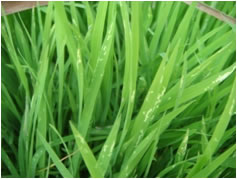
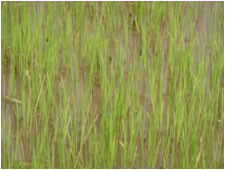
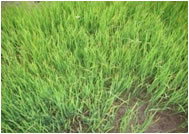
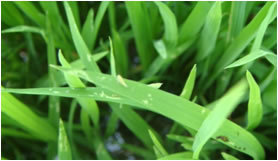
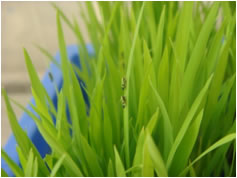
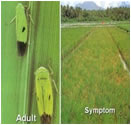

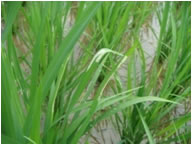
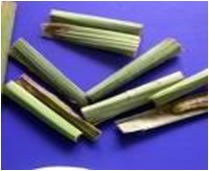
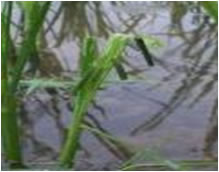
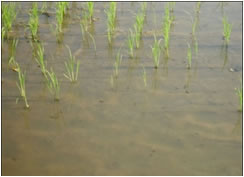
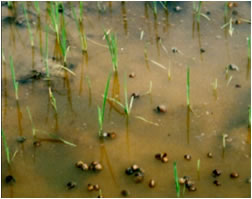
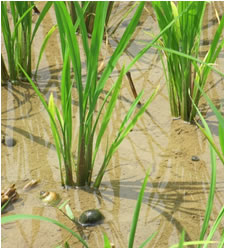
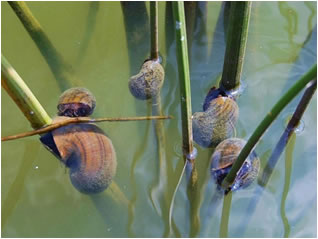
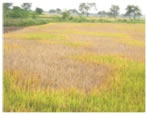
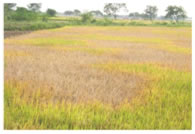
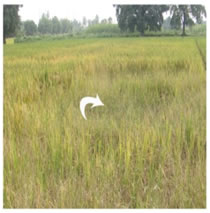
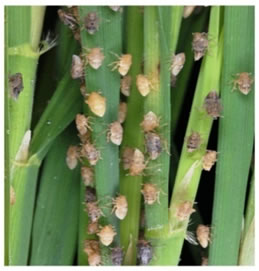
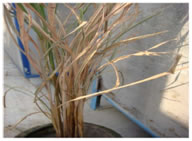
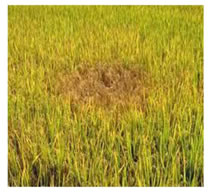
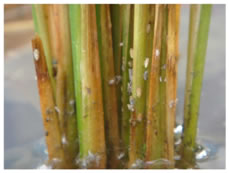
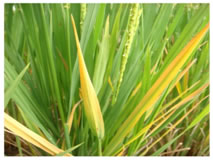
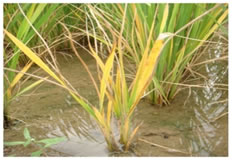
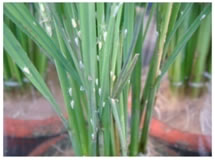
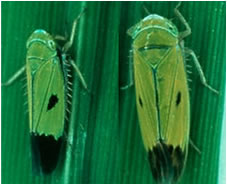
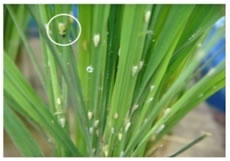
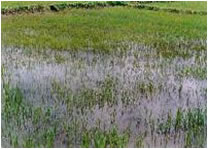
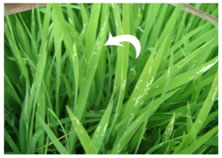
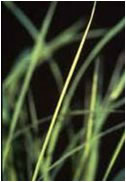
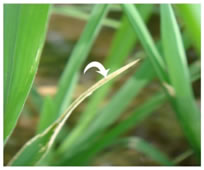
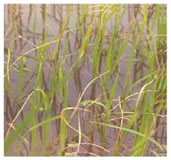
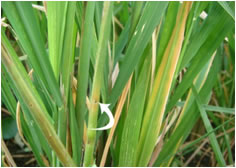
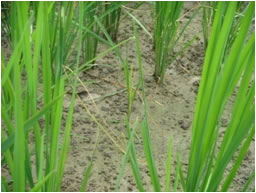
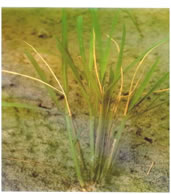
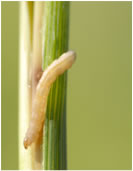
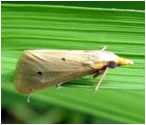
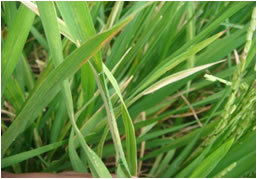
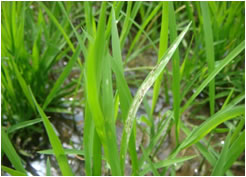
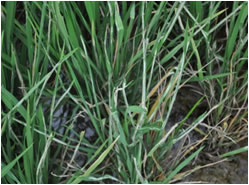
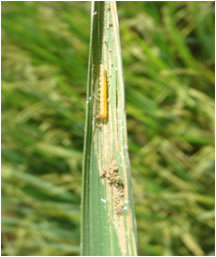
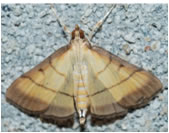
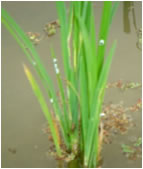
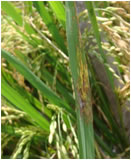
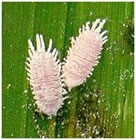
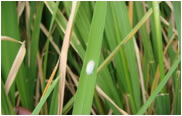
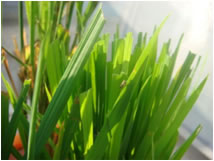
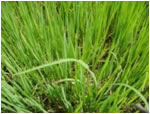
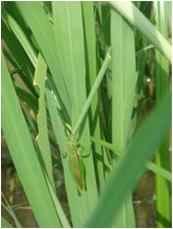
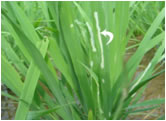
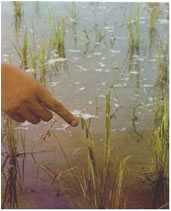
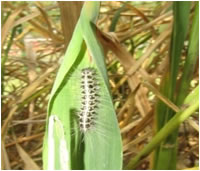
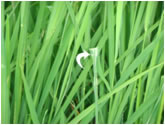
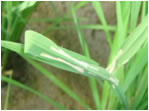
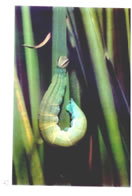
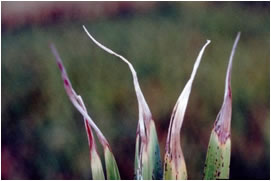
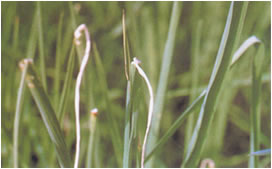
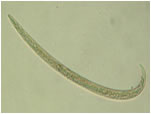
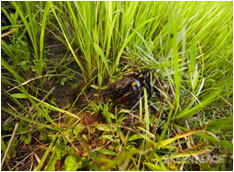
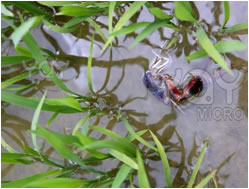
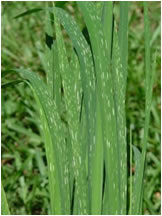
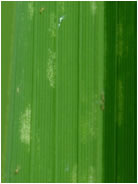
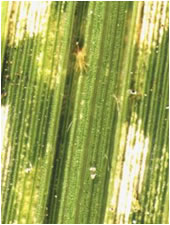
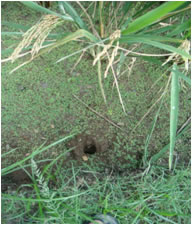
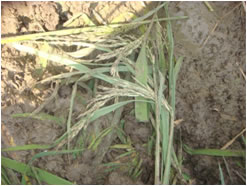
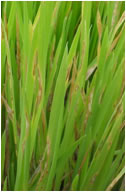
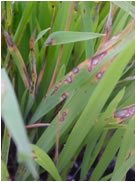

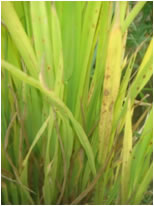
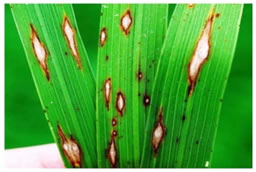
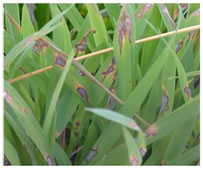
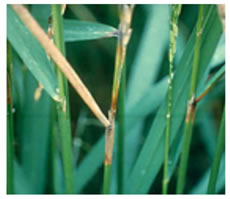
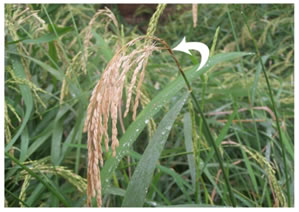
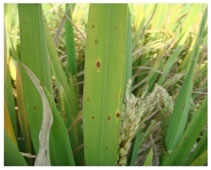
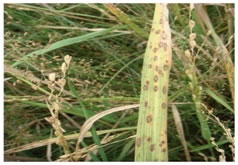
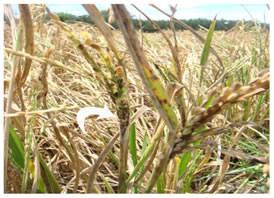
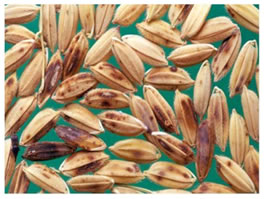
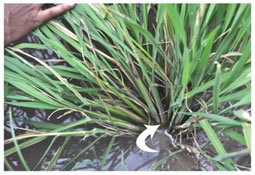
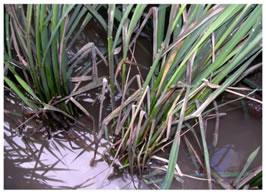
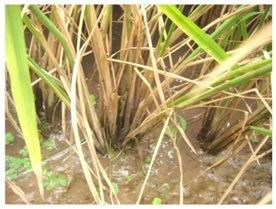
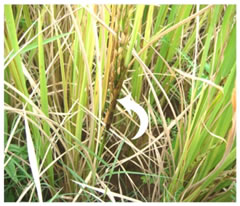
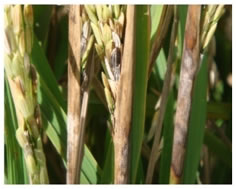
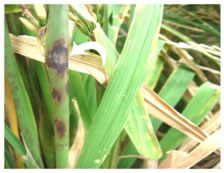
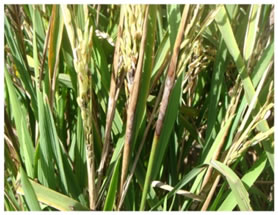
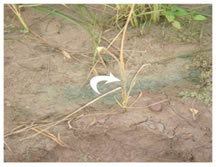
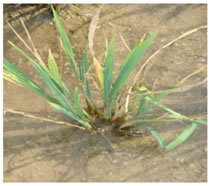
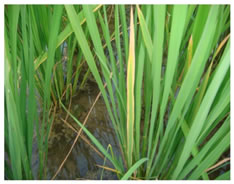
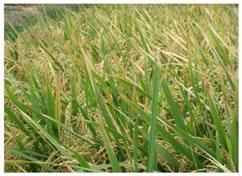
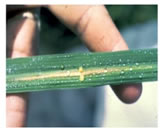
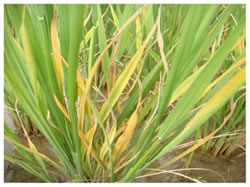
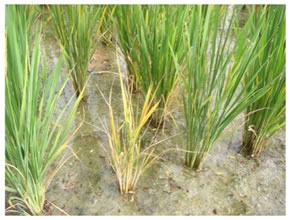
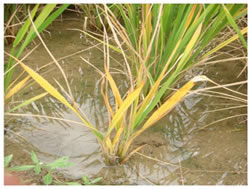
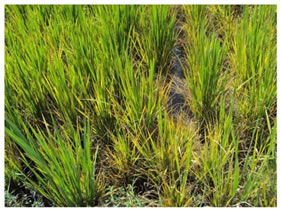
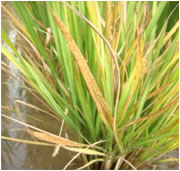
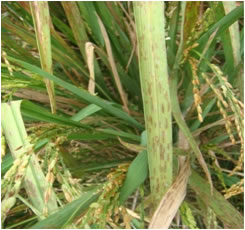
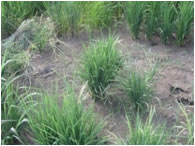
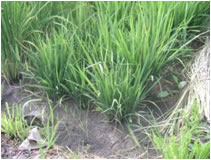 ..
..